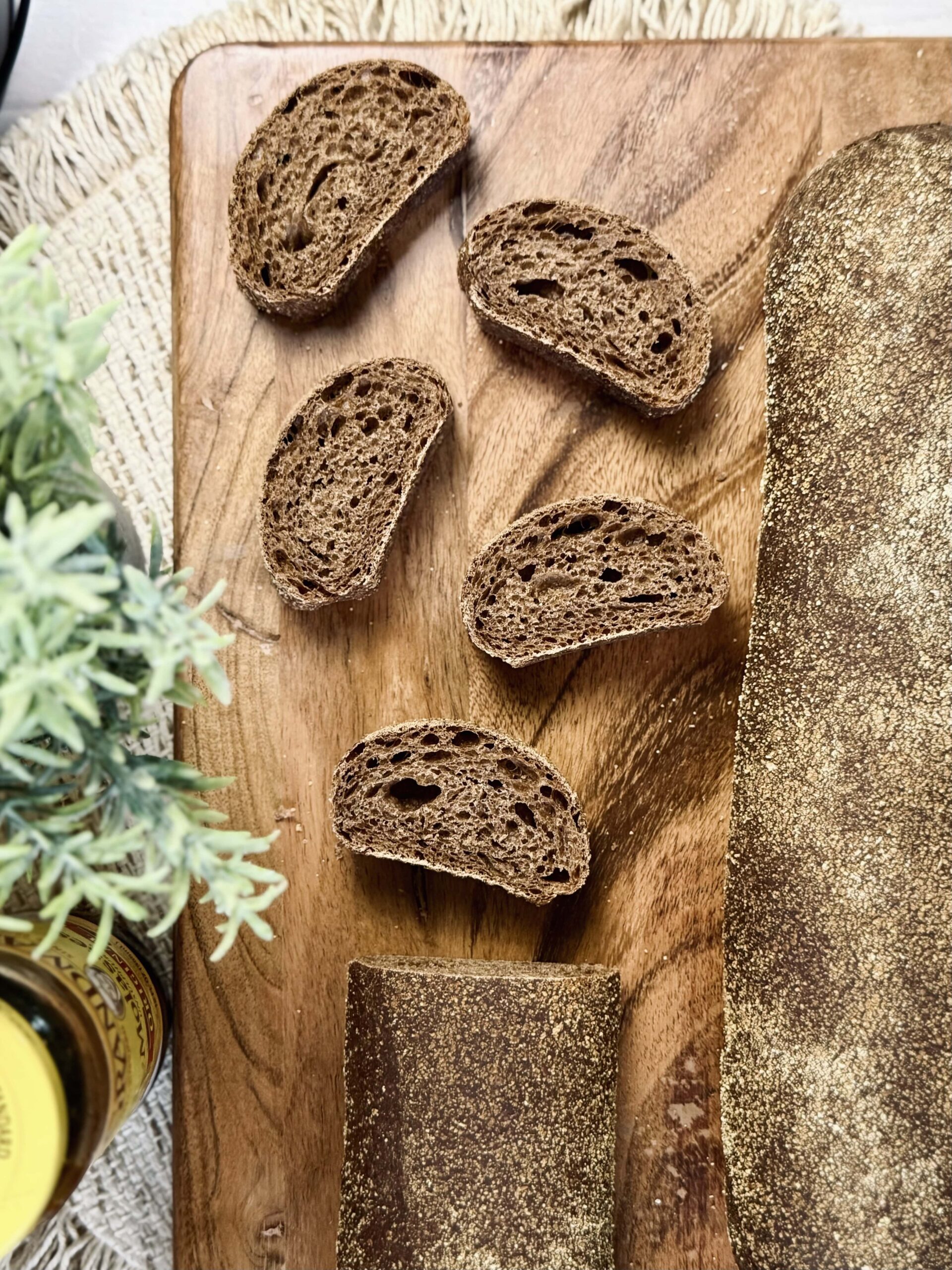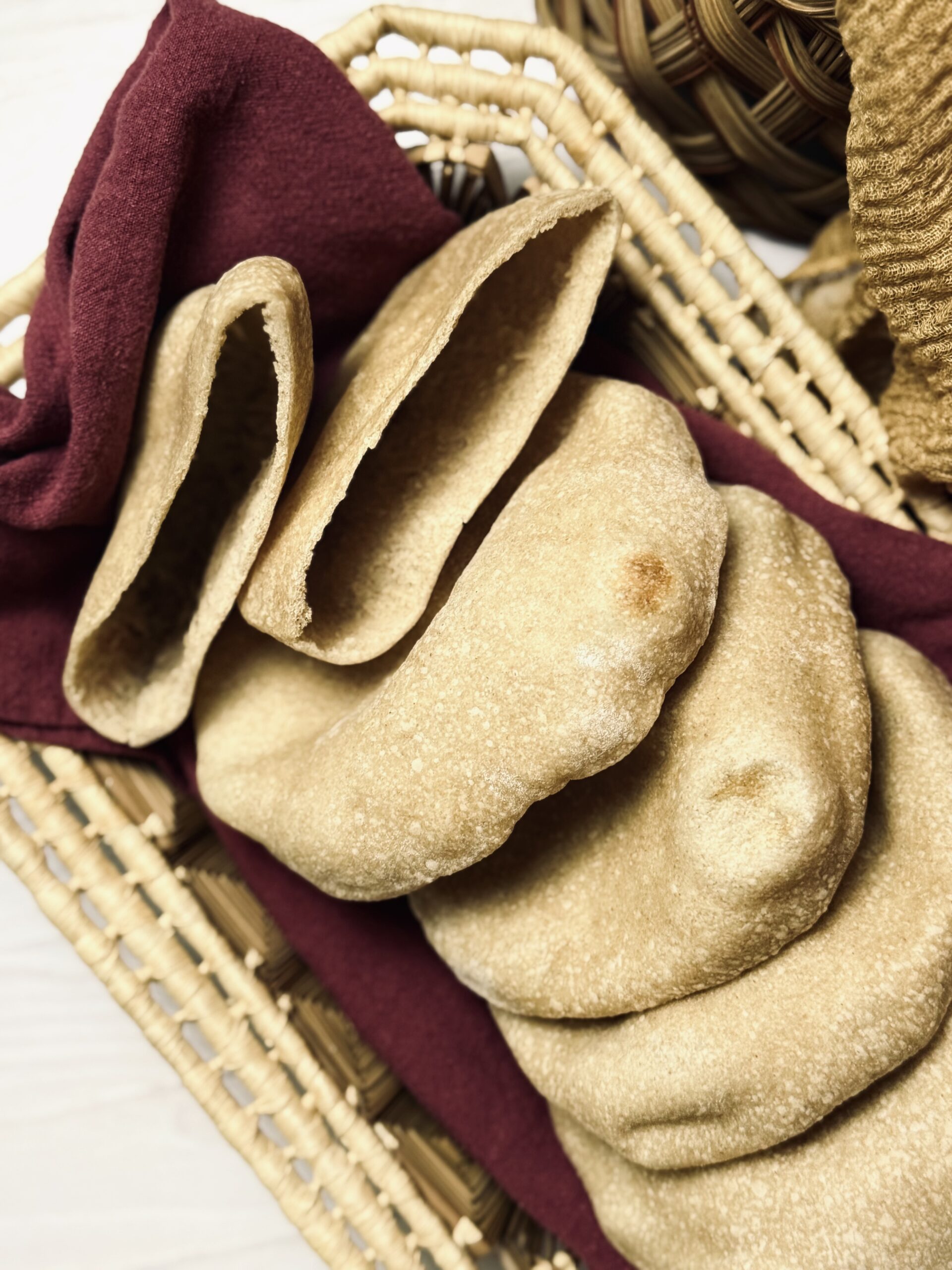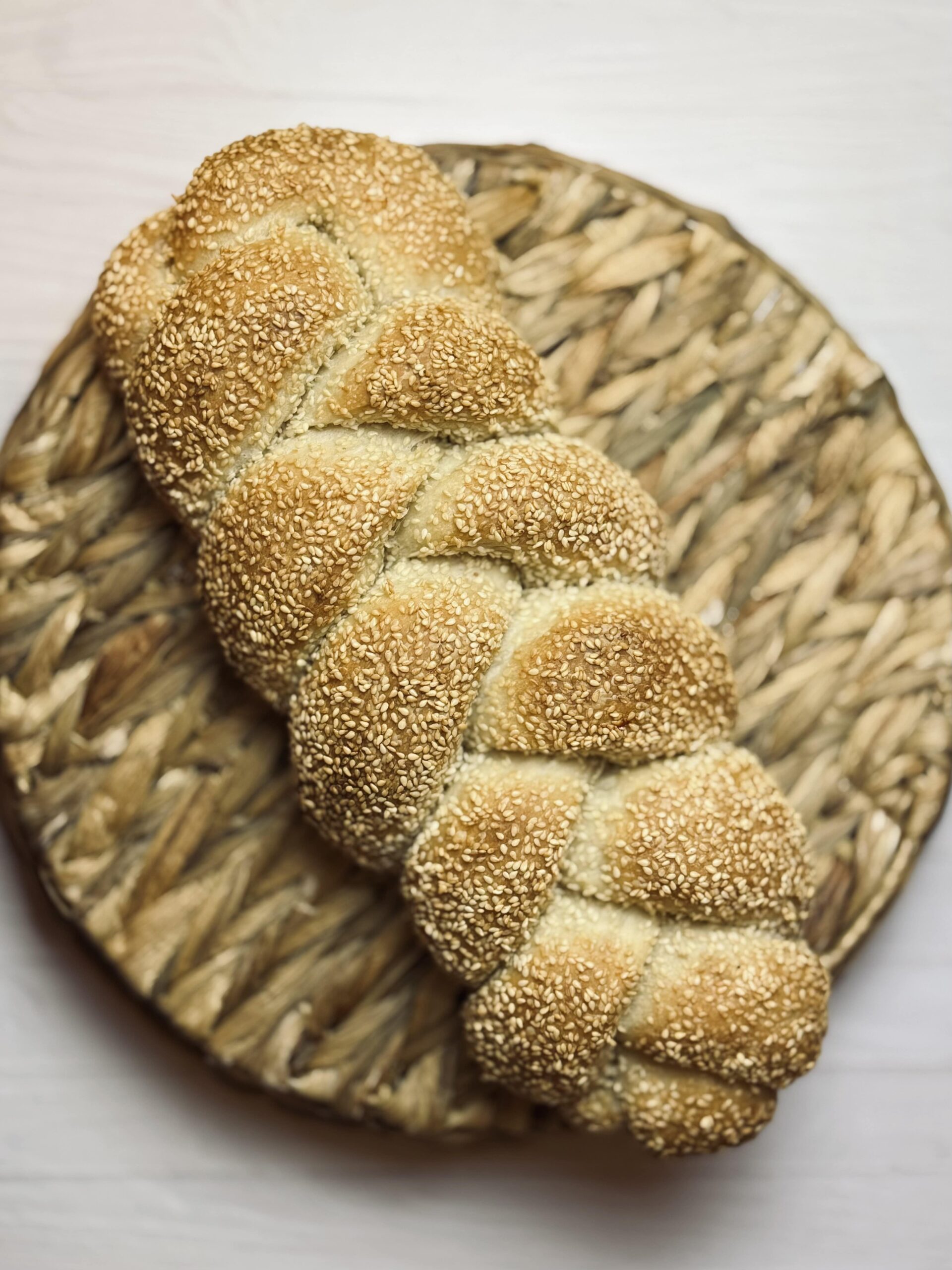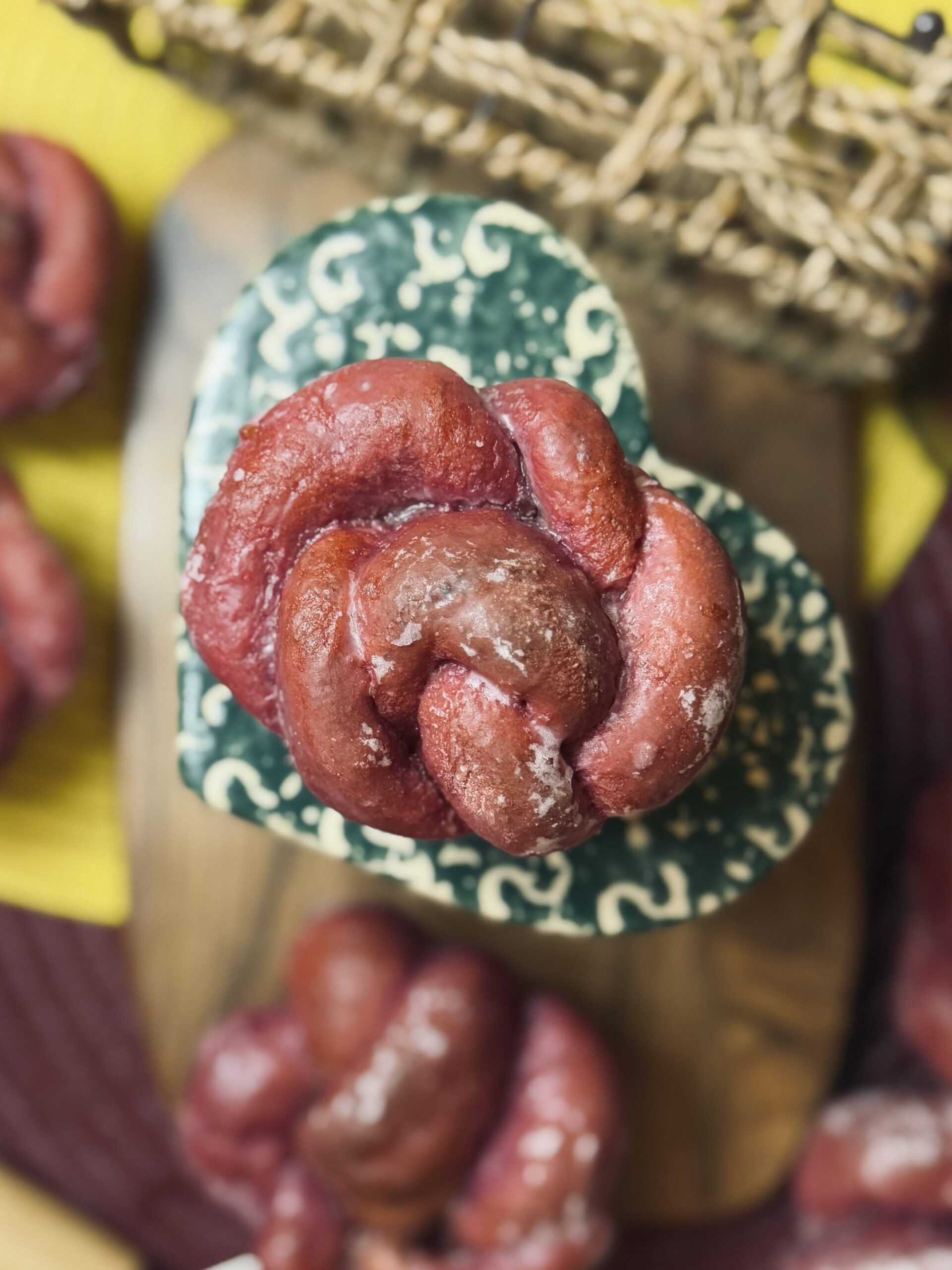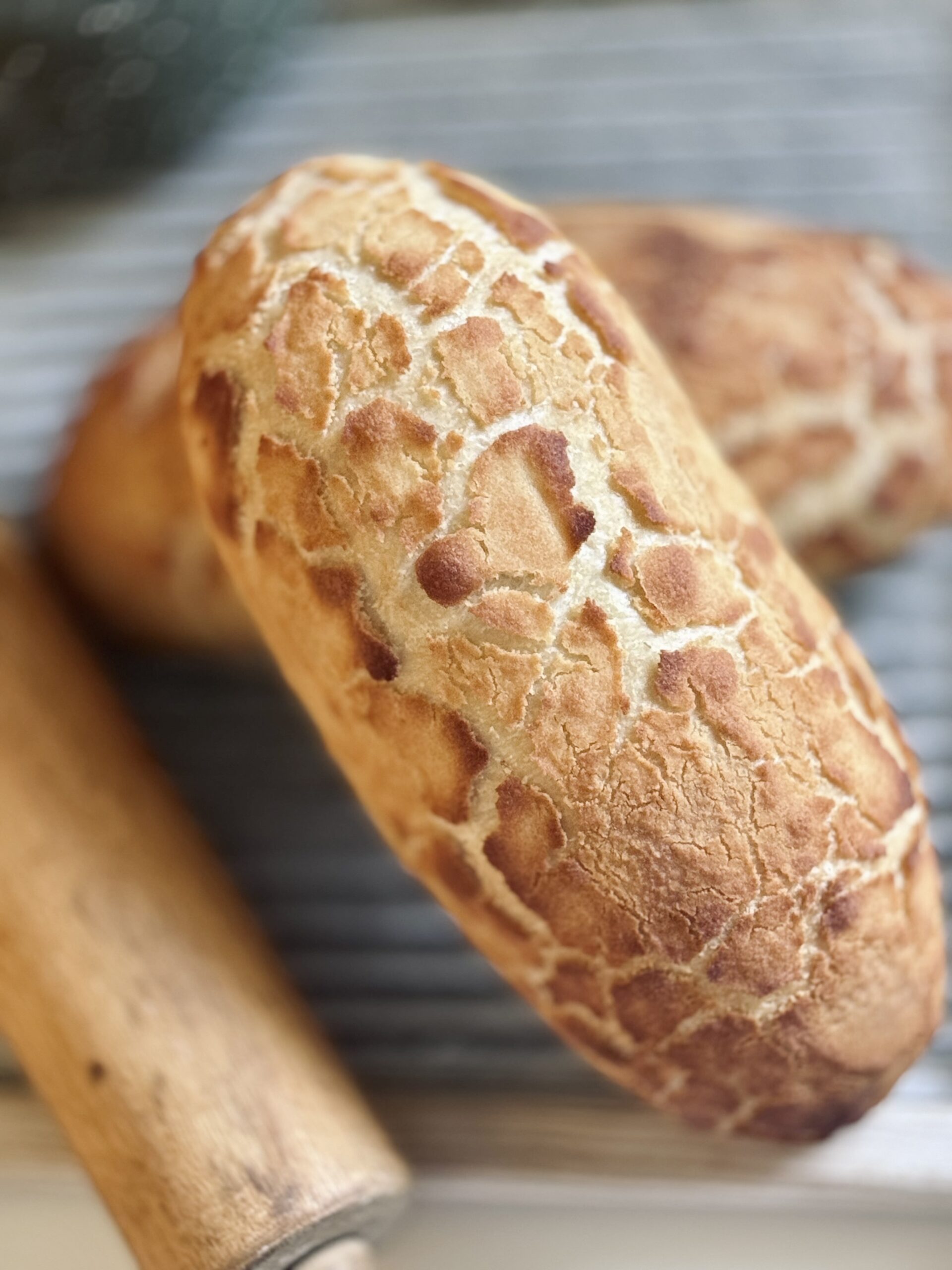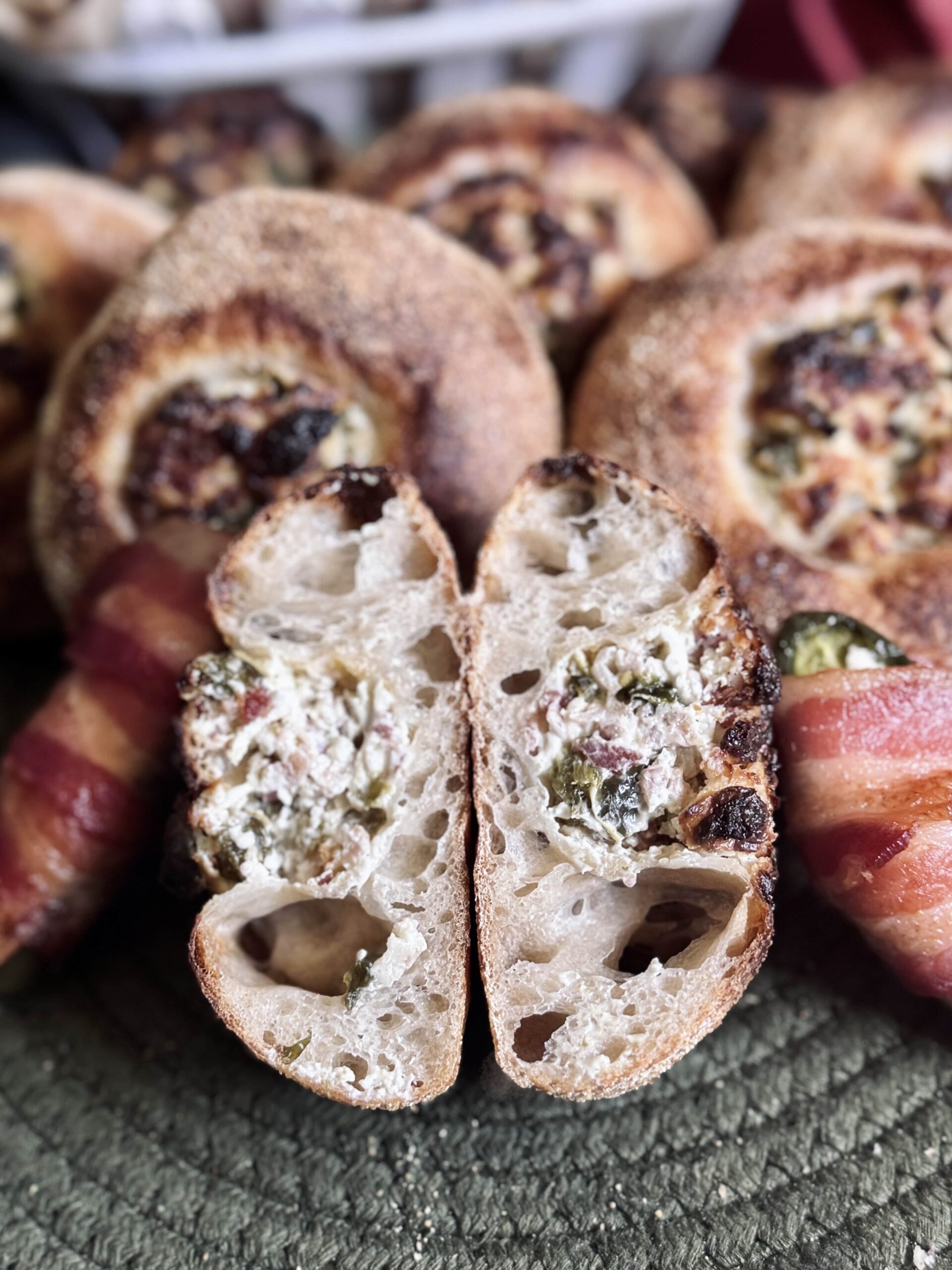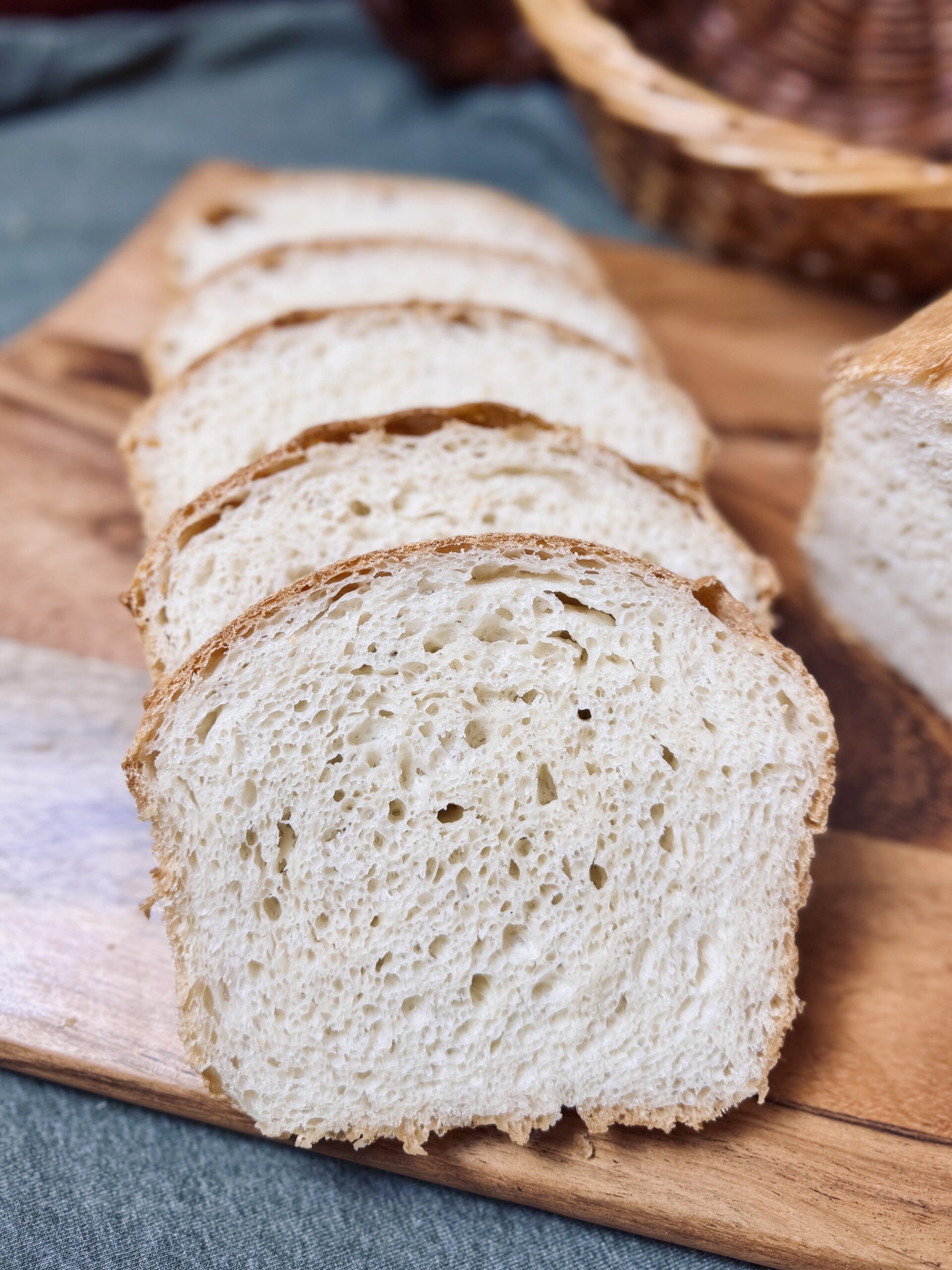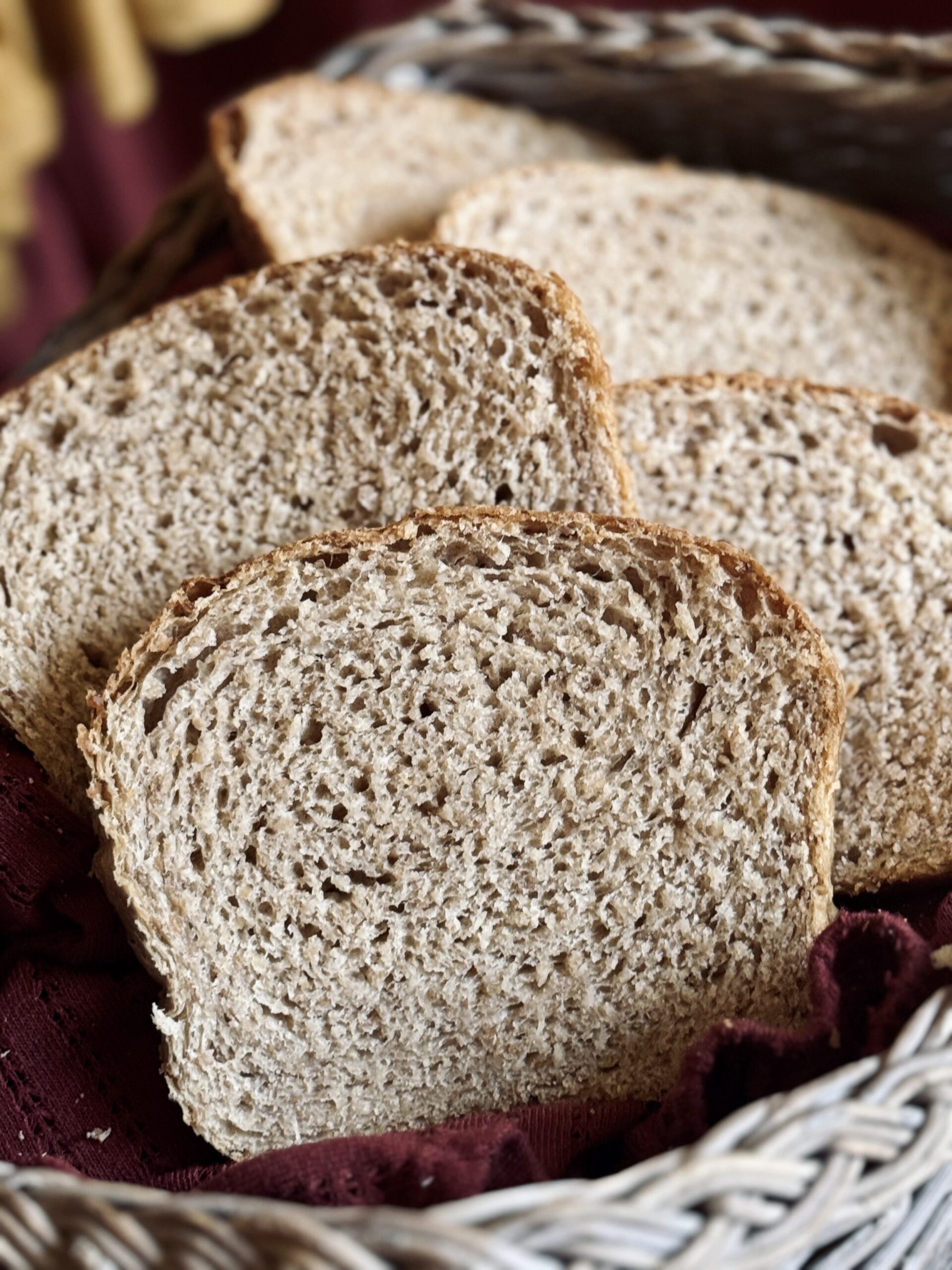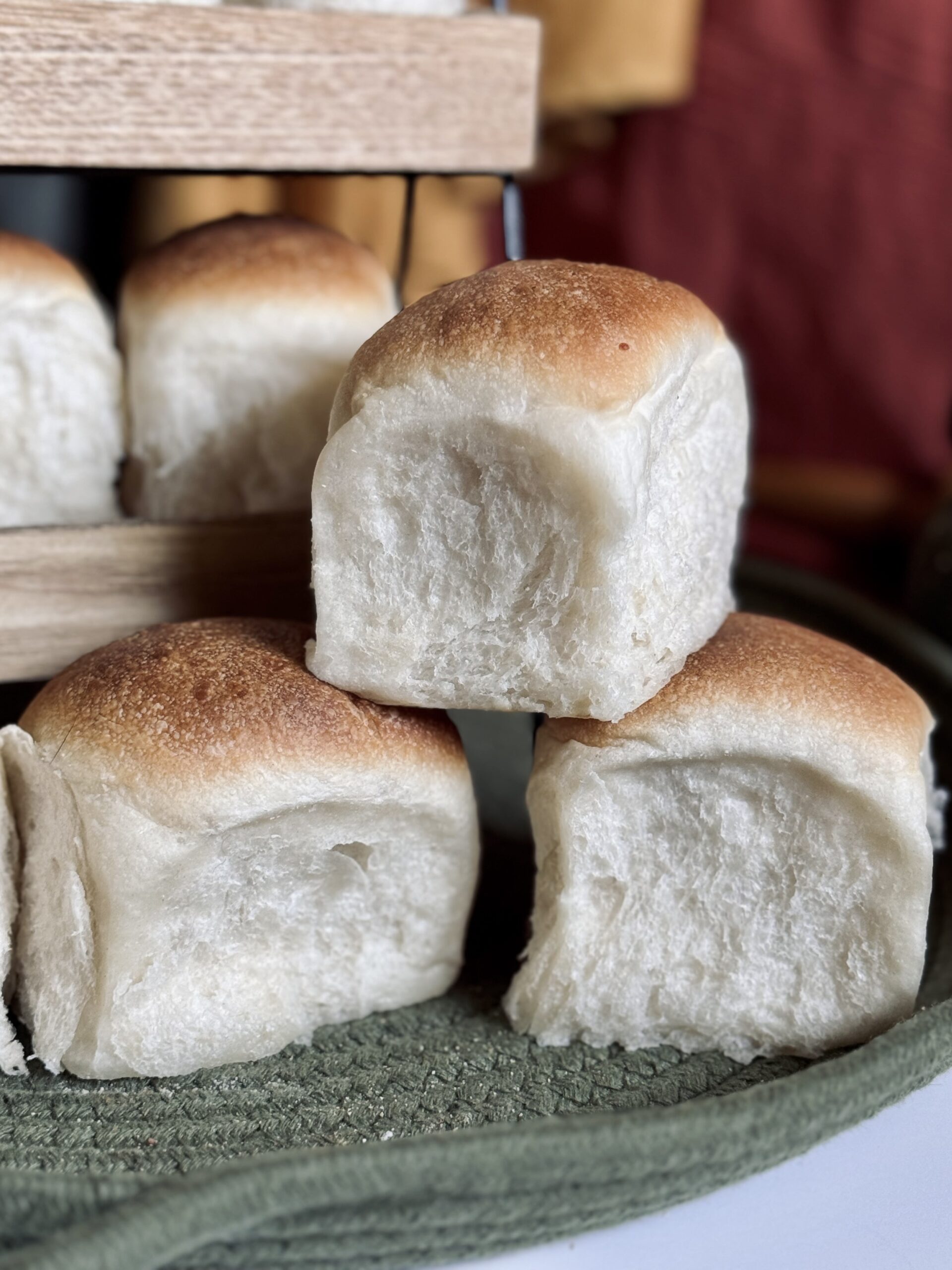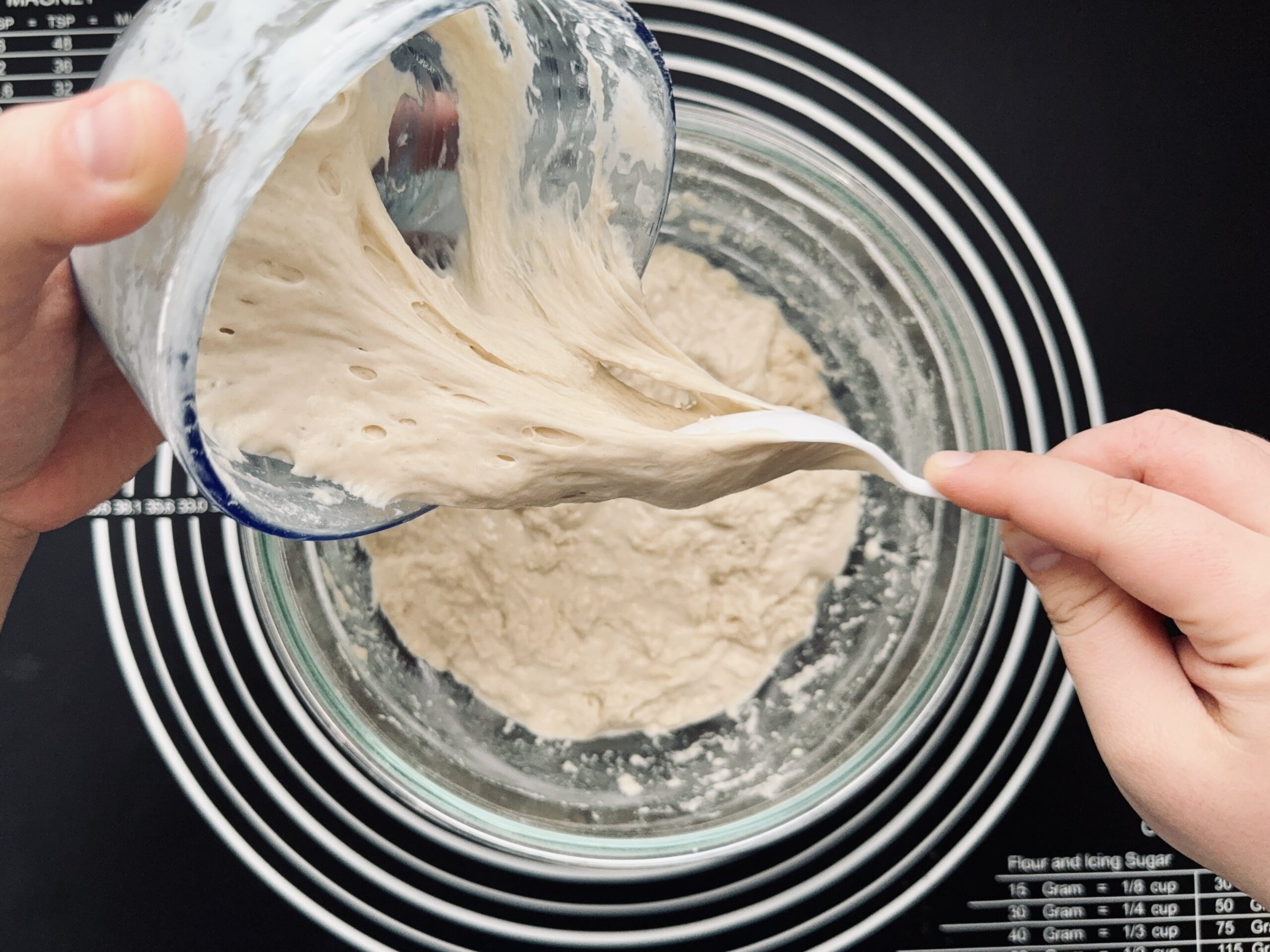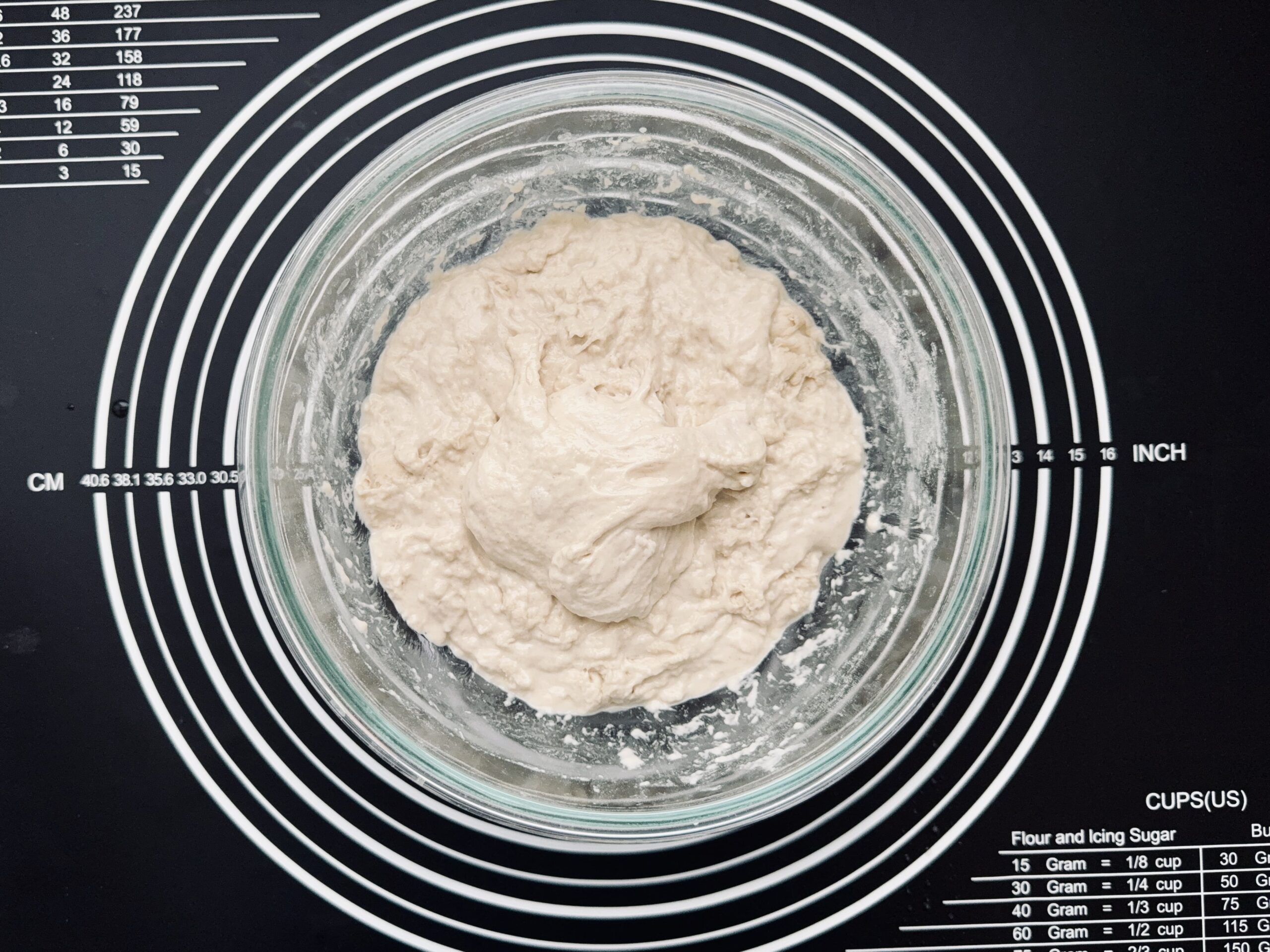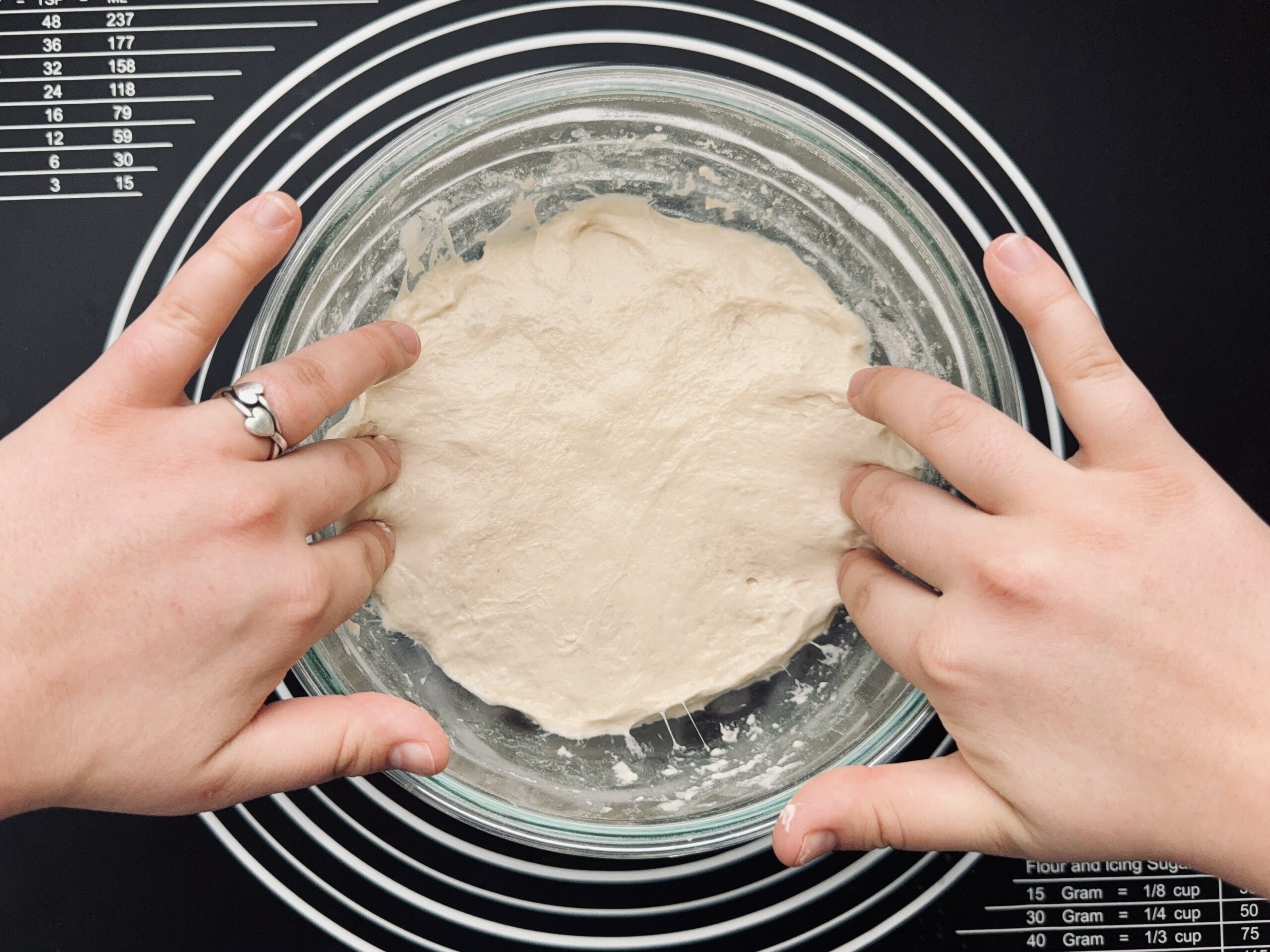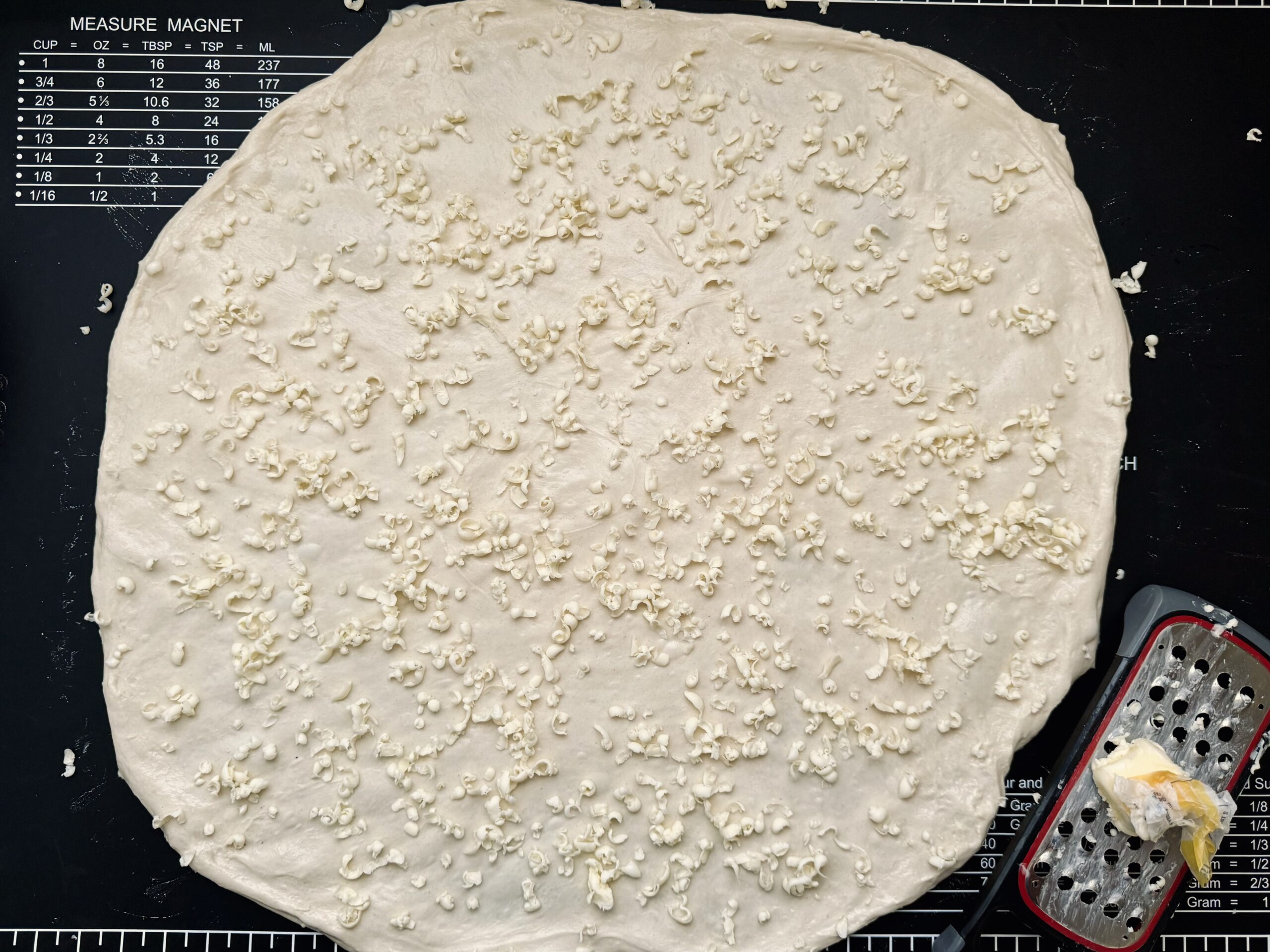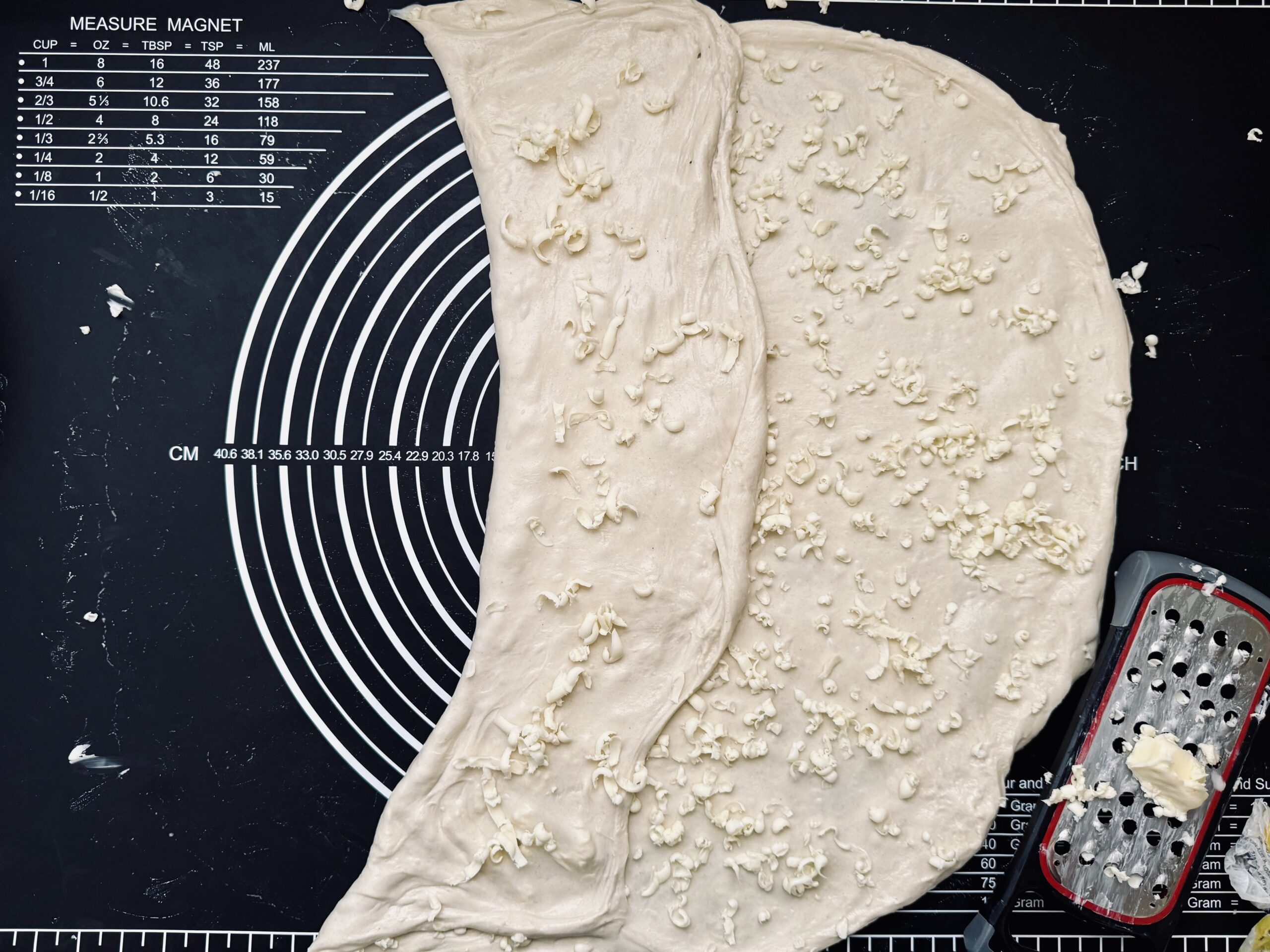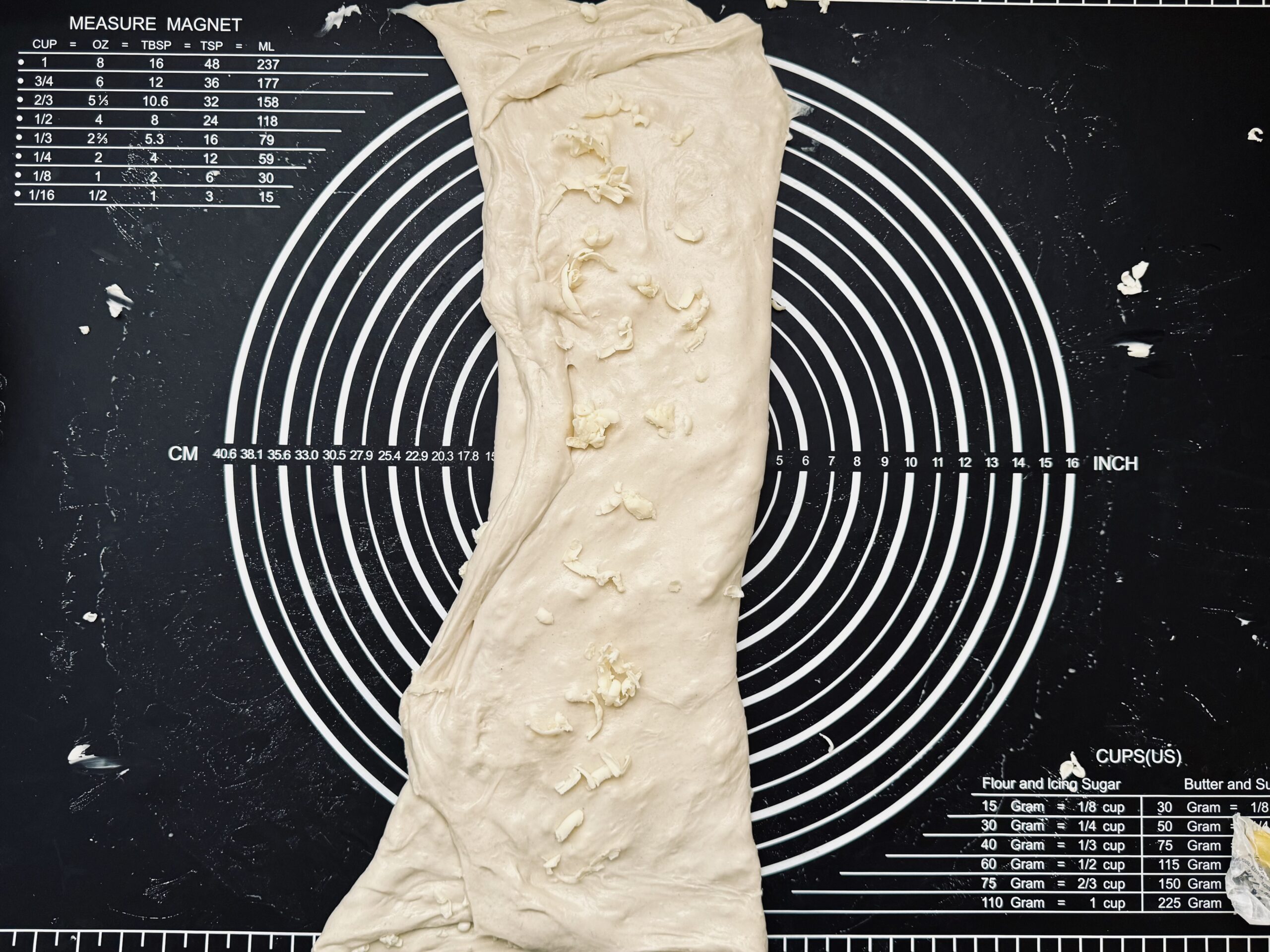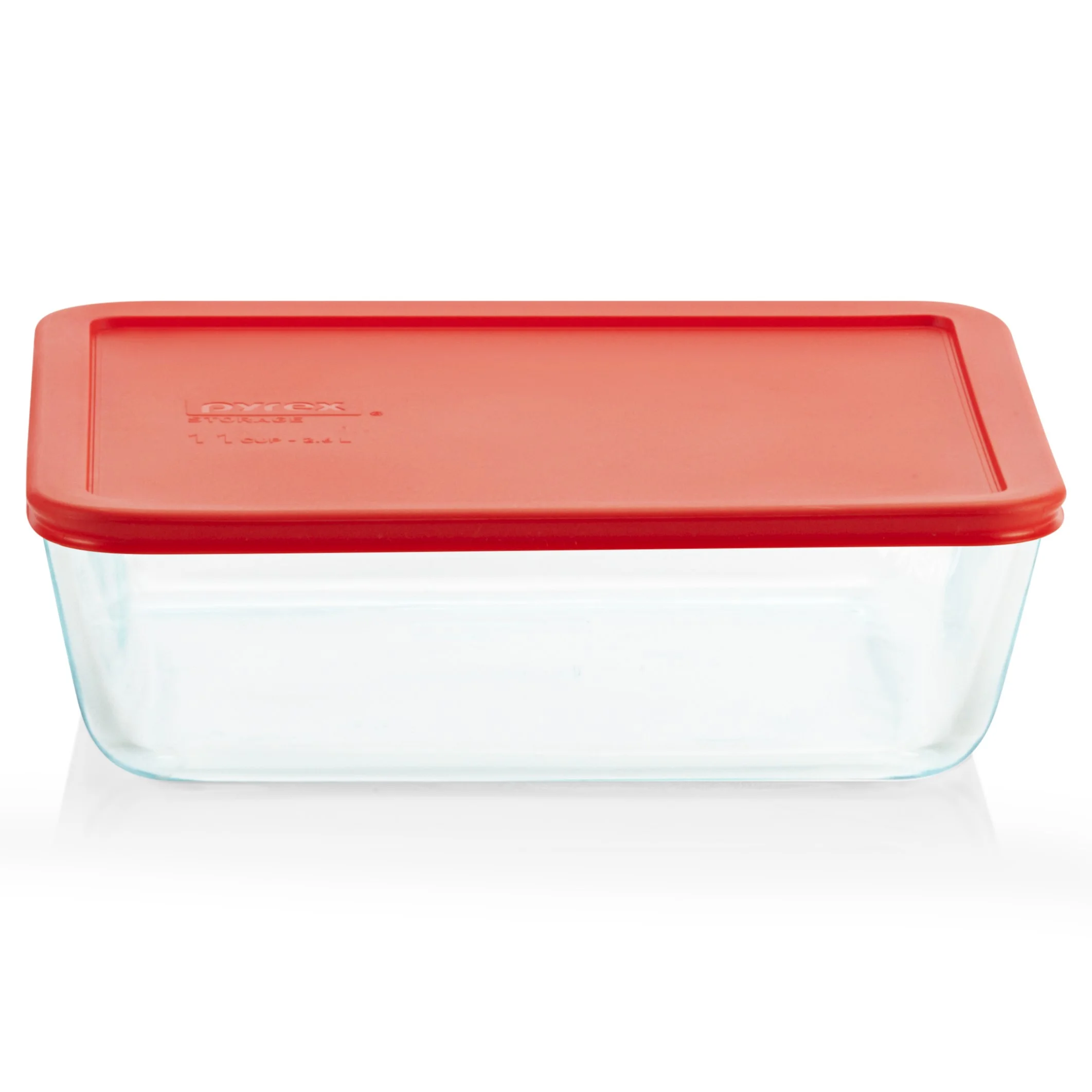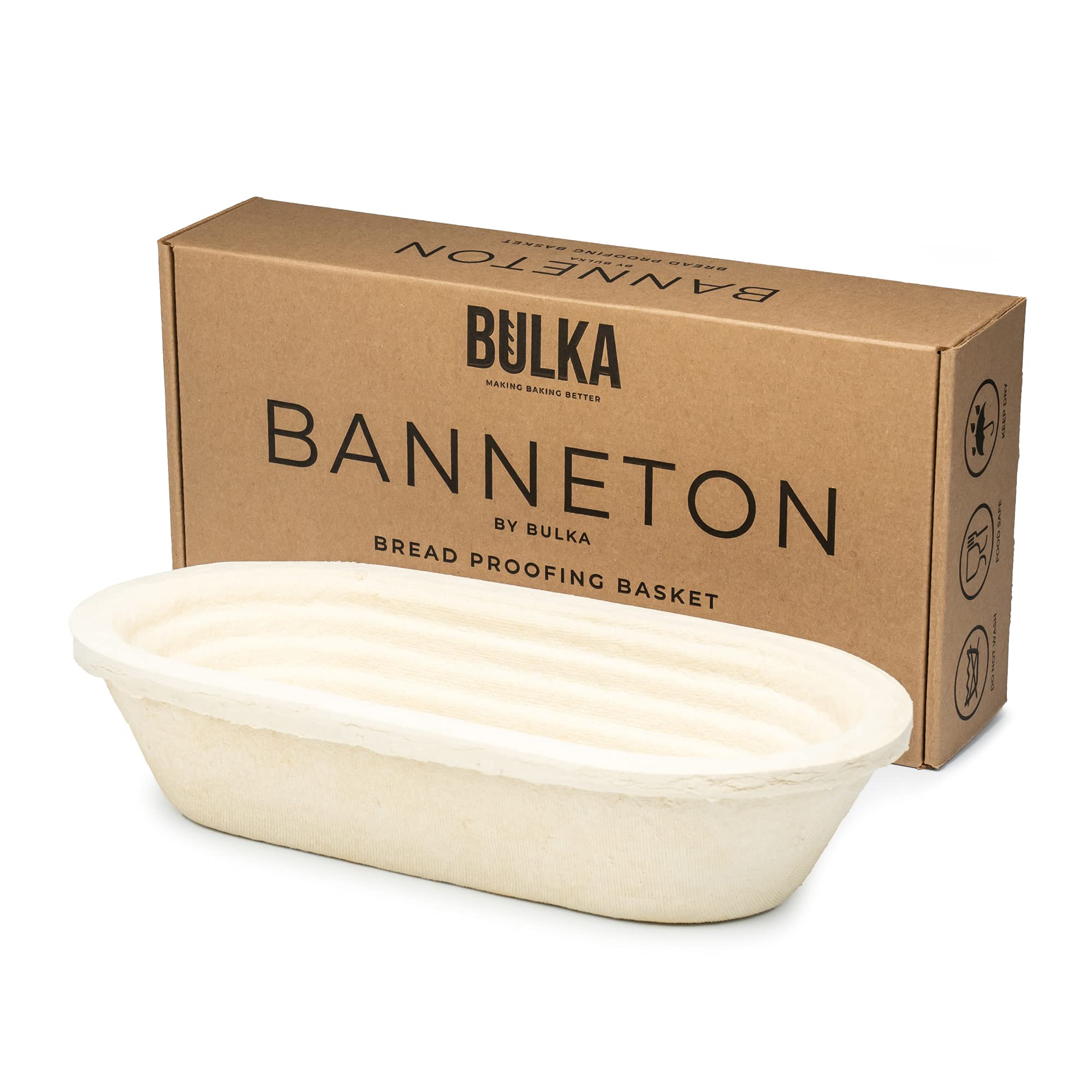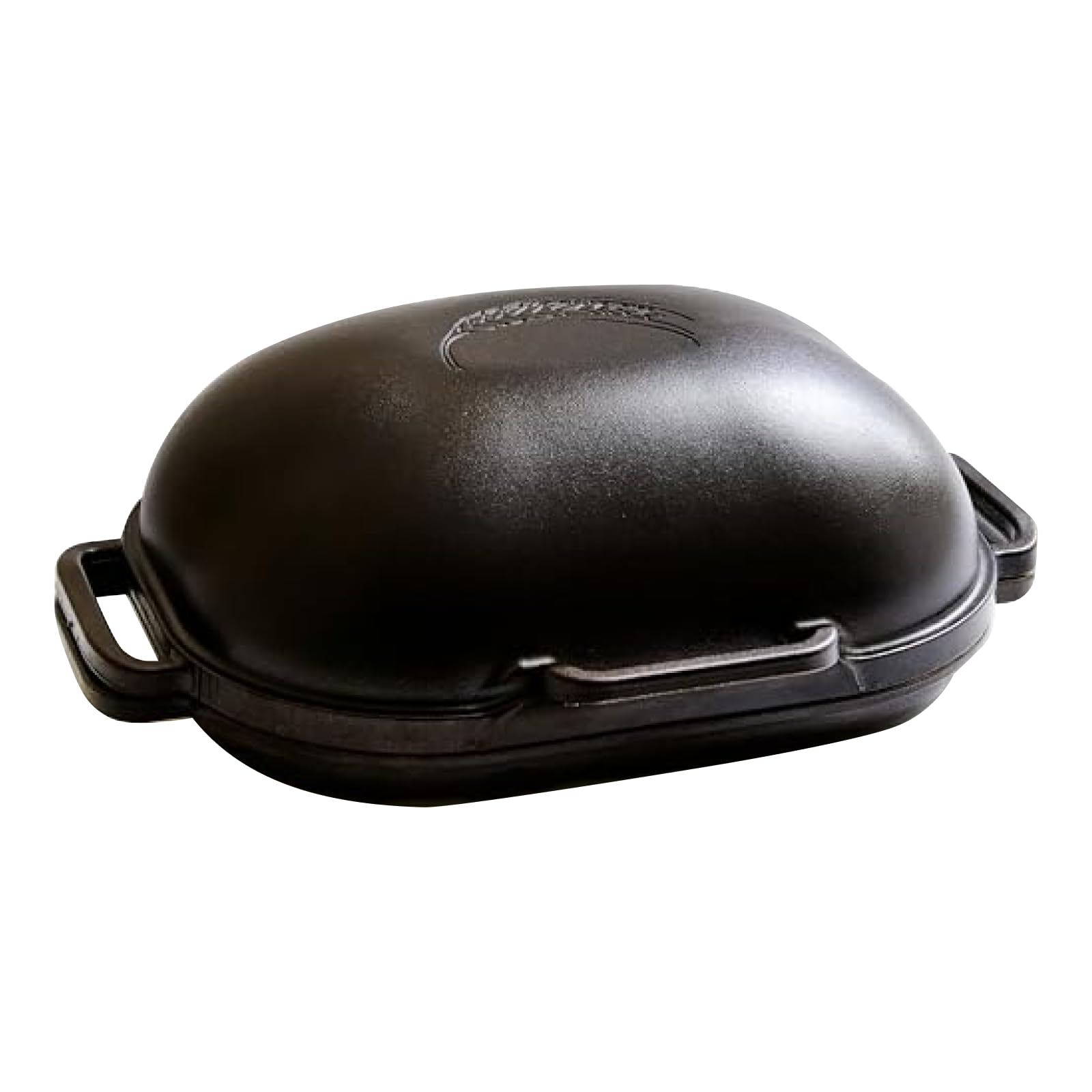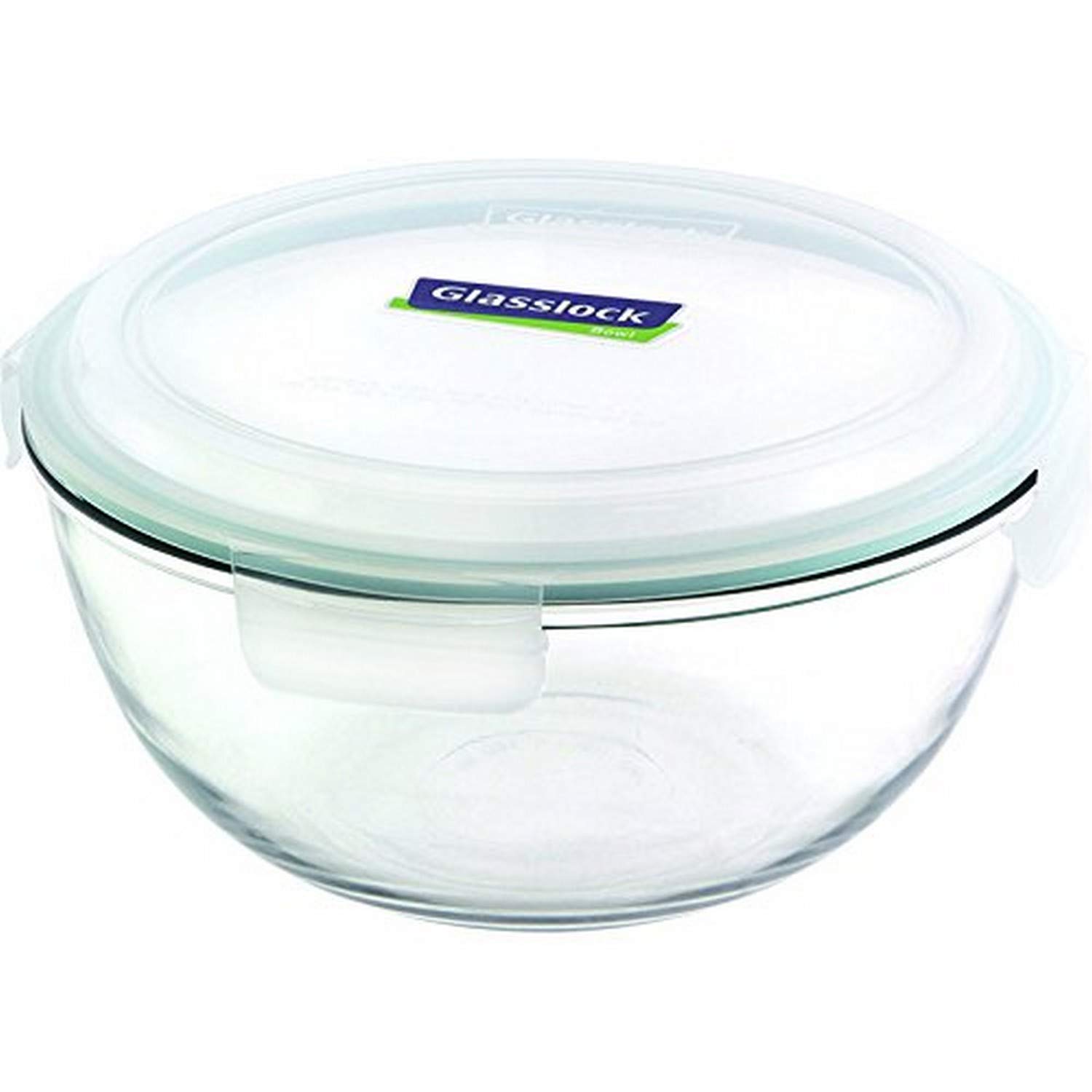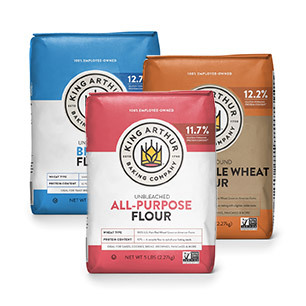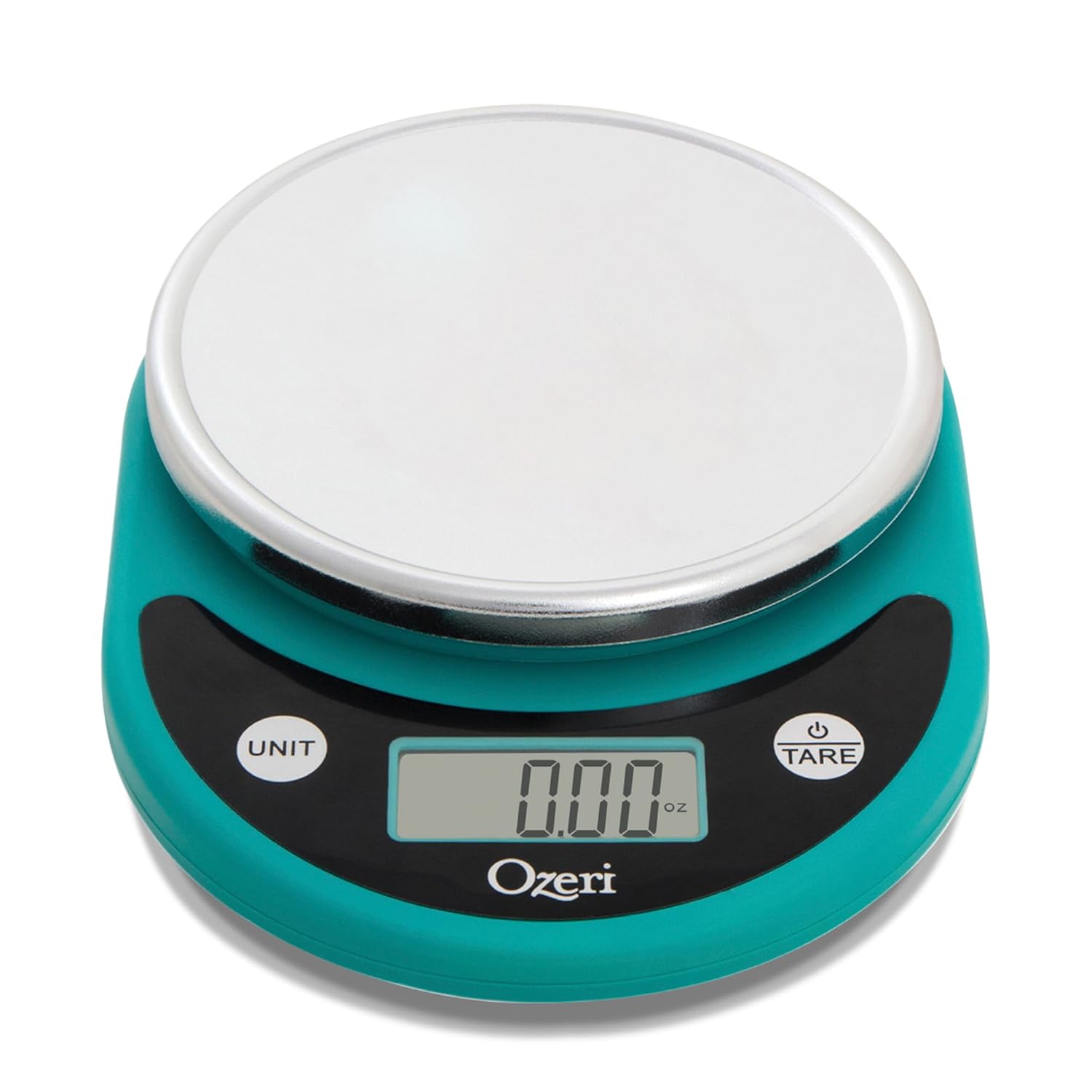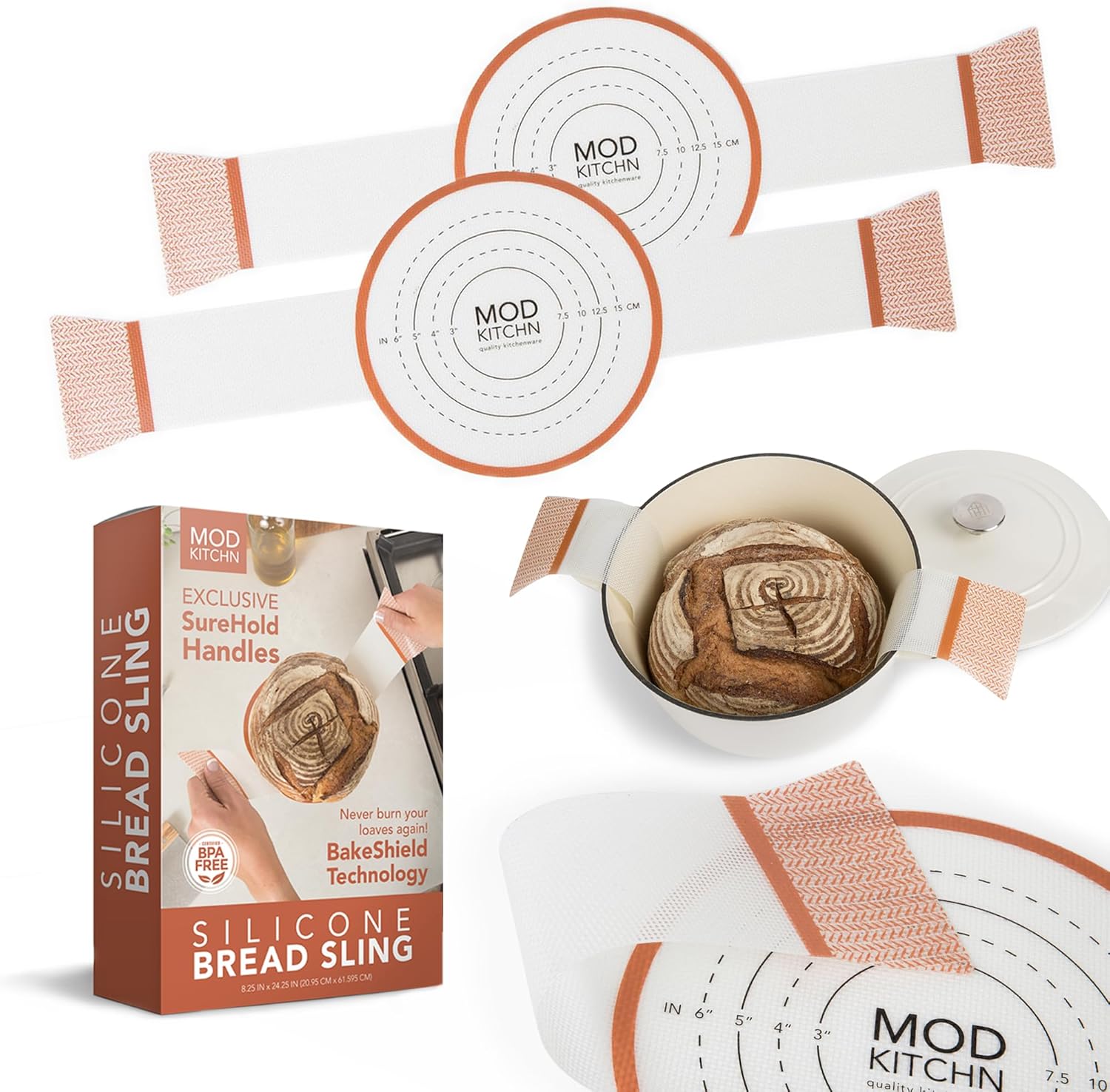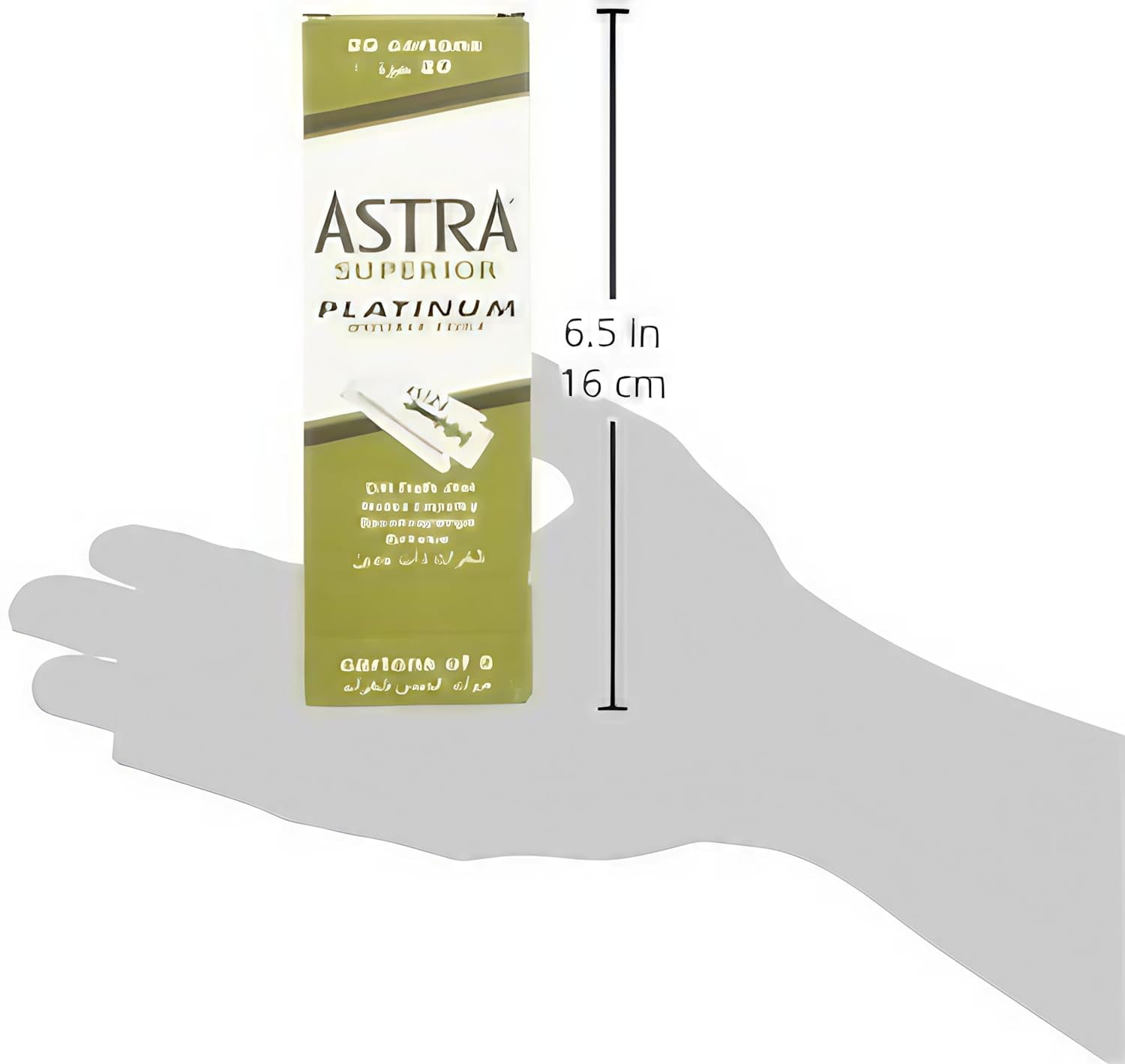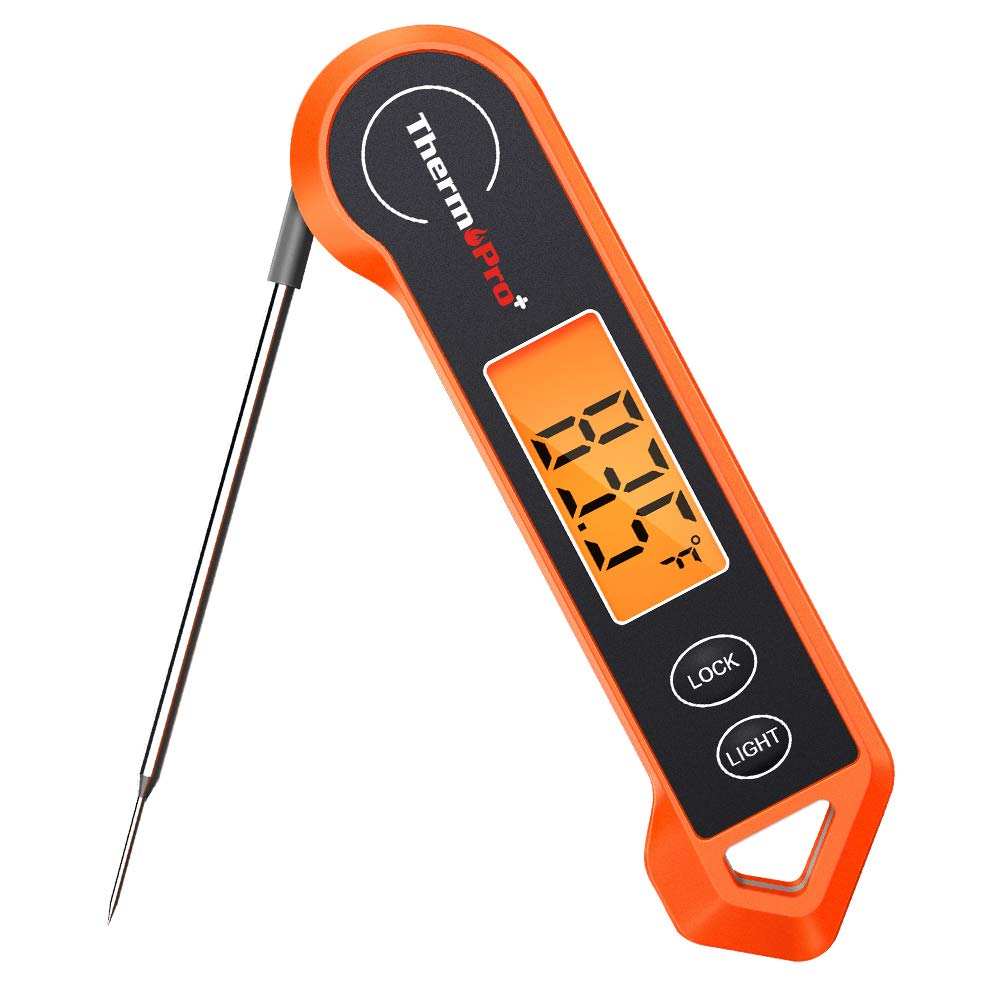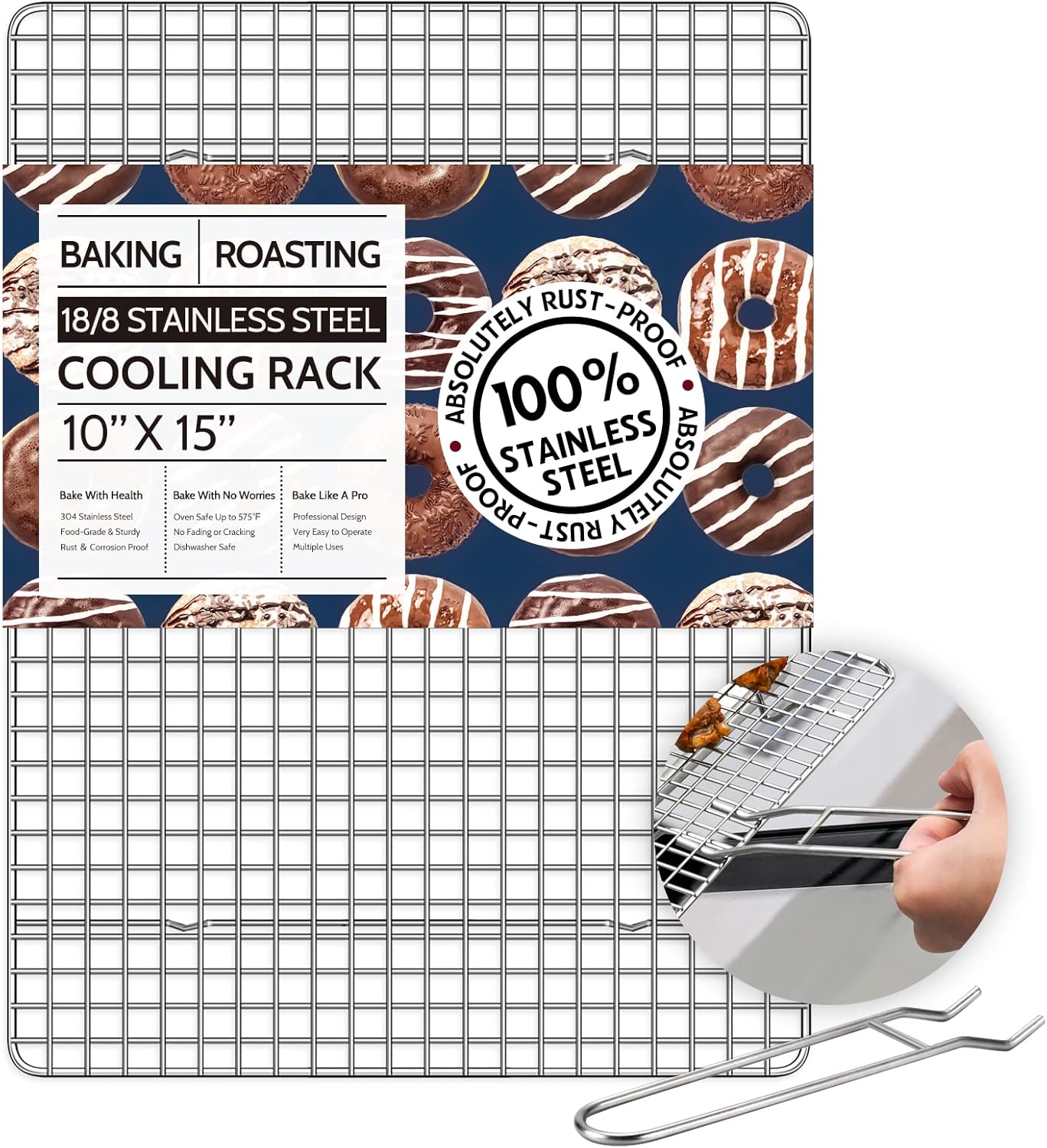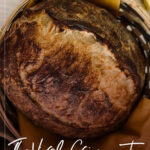About This Recipe
This is the viral croissant bread, originally published by Amy Bakes Bread. Here, I’ve adapted the recipe using my own sourdough methods. The big idea? You’re making a sourdough loaf, but with a buttery twist! This isn’t your average bread; it bakes up soft on the inside, golden on the outside, and packed with rich, croissant-like flavor in every bite.
I’ll be real with you: when I first saw this recipe, I laughed. I’m usually not into shortcuts or “hacks” when it comes to baking. And no, this bread doesn’t magically turn into a real croissant. But it is a totally delicious, creative twist on sourdough bread, and I think you’re going to love it!
Butter As An Inclusion
Instead of mixing the butter straight into the dough like you might for sandwich bread or brioche, this recipe uses butter as an inclusion, meaning it’s layered in after the dough is made. That might sound fancy, but it’s actually what makes this bread unique. By laminating grated, cold butter into the dough (sort of like a croissant, but not really), the butter doesn’t mix all the way in. That means it doesn’t mess with how the gluten forms or make the inside too soft. Instead, it melts in pockets while the bread bakes, creating a flaky, golden crust and buttery layers throughout. The result? A loaf that’s part sourdough, part croissant, and totally irresistible.
What I Love About This Recipe
What I love most about this croissant bread is how simple the process is. It uses my new favorite sourdough method: premixing. It’s mostly hands-off and super simple. Time does most of the work, and you just check in with the dough a few times along the way. Even though butter usually makes things tricky (it can mess with gluten and slow things down), it fits into this recipe without any extra fuss. No endless mixing. No fancy croissant-style lamination. Just a smooth, easy method that gives you seriously good bread.
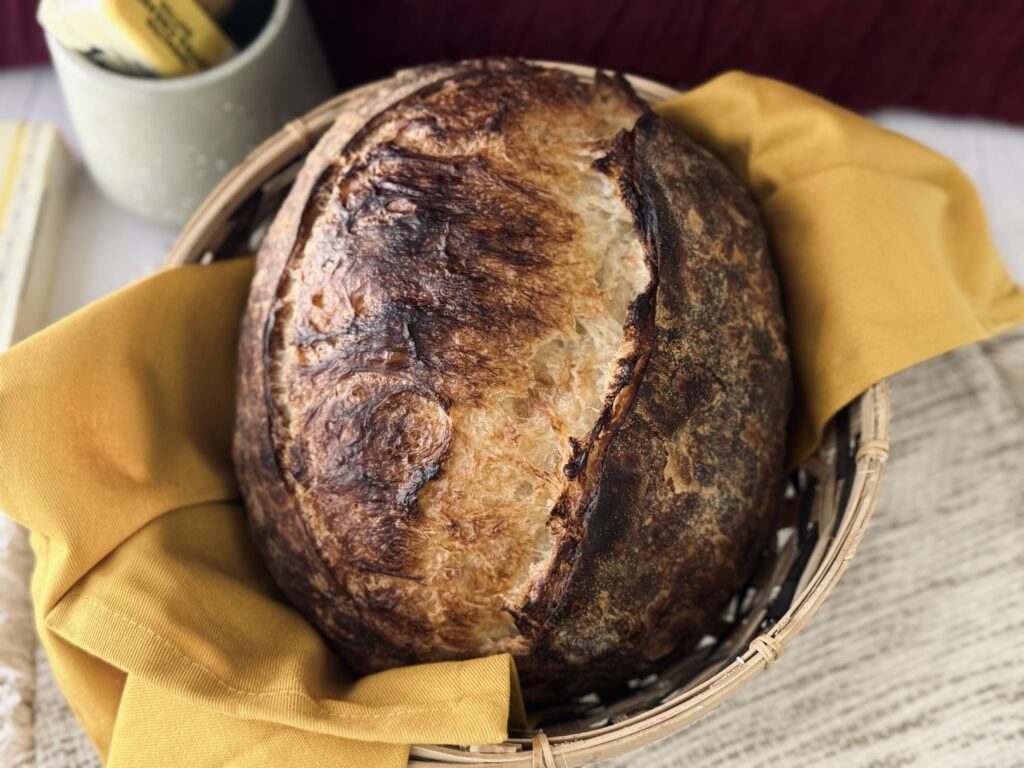
The “Why” Behind The Ingredients
Bread Flour
In my book, bread flour is a must for making great bread. Bread flour has more gluten-forming proteins, which naturally build a stronger gluten network. This helps trap air better during fermentation, leading to a lighter, airier texture. It’s especially important in a recipe like this one, where most of the dough’s strength comes from time (premixing, lamination, and just a few folds).
You can use all-purpose flour if that’s what you have, but you might notice some differences. The dough might not hold air as well, and it can sometimes tear during folds or shaping. These are signs of weaker flour, which usually means a denser loaf that spreads out more instead of rising tall. If you notice this happening, I definitely recommend trying the recipe again with a different flour.
For most recipes that call for “bread flour,” I use King Arthur Bread Flour because of its higher protein content (12.7%) and amazing gluten strength. I’ve also tested this recipe with Bob’s Red Mill Artisan Bread Flour (around 12.5% protein). It’s a little softer overall, but it still works just fine here.
Salt
When it comes to salt, I like to use a fine salt without any anti-caking agents. Fine salt dissolves more easily, and skipping the caking agents means a cleaner dough. Lately, I’ve been loving Redmond’s Real Salt for all my bread recipes.
Salt does way more than just make bread taste good (without it, bread would honestly taste like nothing). It also acts as a tightening agent, helping to create a stronger, more elastic dough. On the flip side, salt does slow down fermentation and gluten development a little—but that’s totally normal and something we plan for when building the recipe. Bread needs salt, no question about it. The key is using just the right amount: enough to bring out the flavor without stopping the dough from rising properly. I stick with the standard 2% salt in all my recipes, unless I specifically say otherwise.
Sourdough Starter
If you know me, you know I’m all about keeping a healthy starter. For the best fermentation, feed your starter at a higher ratio, about 1:5:5 or 1:6:6, to cut down on acid buildup. Let it ferment somewhere in the 70s F (ideally 73–75 F, or 23–24 C) to favor yeast growth and keep the acid levels balanced. At this feeding ratio and temperature, your starter should triple in size in about twelve hours.
If you want to go the extra mile, you can give your starter one or two sets of stretch-and-folds during the first four hours of fermentation. This traps extra oxygen and encourages the yeast to pump out more CO2 (and less ethanol), which helps it rise higher and keeps the alcohol flavor mild.
After about twelve hours, you can take what you need to refresh your starter or tuck some away for maintenance. I like to give it one more set of folds at this point, then let it rest for another 3–4 hours. It should double or triple again during this time. When I’m ready to mix the bread dough, I usually stir the starter down at the same time I premix the rest of the ingredients.
Cold Butter
In this croissant sourdough bread recipe, butter is the star, and using cold butter really makes a difference! We’re not trying to make a brioche-style bread, where lots of butter gets mixed right into the dough. Instead, we’re going for a croissant-style effect, where the butter is layered in. Cold butter acts as an inclusion, not an ingredient. It’s easier to grate and layer when cold, and it stays in place during baking, creating pockets of melty butter that give this loaf its amazing flaky texture. Keeping the butter cold also stops it from melting into the dough too early, so you get distinct layers instead of a heavy, blended loaf. I actually freeze my butter first, then grate it straight over the dough during lamination for the best results.
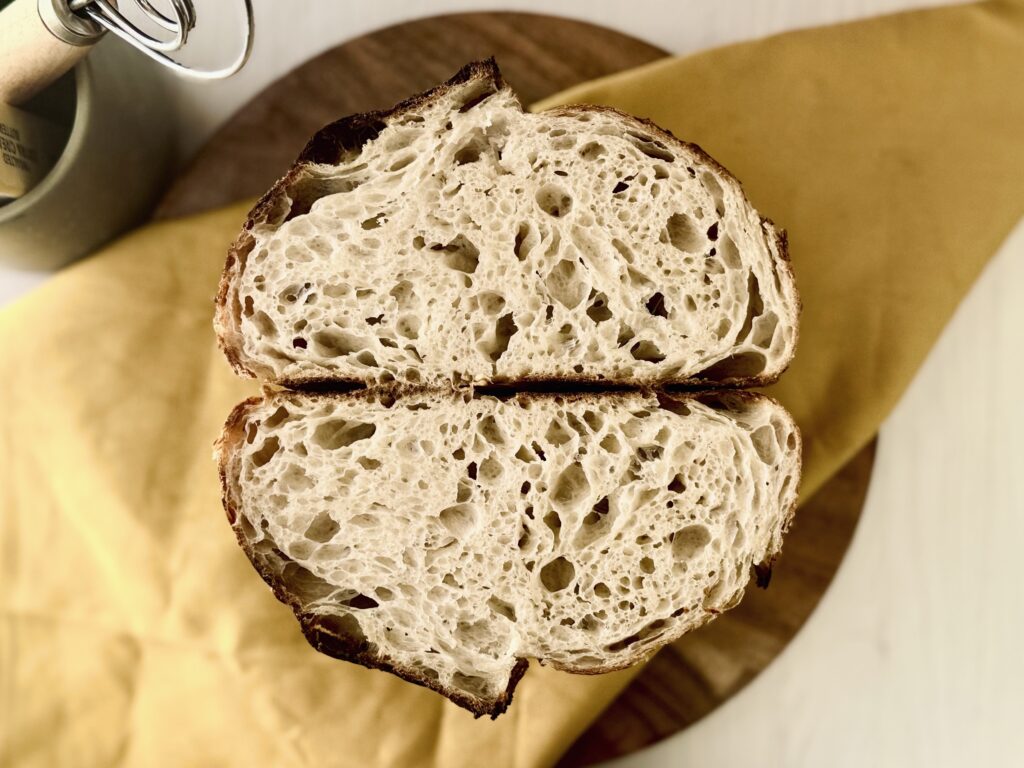
The “Why” Behind The Method
Hydration
While I love working with higher hydration doughs (meaning doughs with more water), I know that’s not everyone’s cup of tea. For this recipe, I’ve set the hydration around 80%, which works really well with the type of flour I use. It creates a soft and supple dough that naturally builds gluten over time, without requiring a lot of hands-on time. It’s also just the right hydration for easy coil folds (the dough isn’t too stiff), and the final bread has a texture that feels perfectly balanced.
You might need to tweak the water amount slightly depending on your flour, but I don’t recommend changing the dough’s overall consistency. Doing so would throw off the whole process and give you very different results.
You can read more about dough hydration (in general) here.
Premixing Method (For Dough And Gluten Development)
Premixing has become my new obsession because it does so much for the dough with almost no extra effort from the baker. Time does most of the heavy lifting, and we’re just there to give a little support along the way. It creates a dough with a beautiful crumb, great oven spring, and a texture that’s easy to work with (and super versatile!).
The reason premixing works so well is because this dough is unenriched. And, yes, it is unenriched even with the presence of butter. That’s because (remember?) butter is an inclusion in this recipe, not an ingredient in the dough! That means gluten bonds naturally start forming the moment flour and water meet, and they keep getting stronger over time.
Time doesn’t just build gluten, it also gives enzymes a chance to go to work. Amylases break down complex carbs into simple sugars, creating easy food for the yeast once the starter is added (you can read a bit more about that here). At the same time, proteases start breaking down proteins, helping the dough become more stretchy and extensible.
Another bonus: time lets the flour fully absorb the water, making the dough much less sticky and way easier to handle.
Now, unlike an autolyse or fermentolyse, premixing includes the salt right from the start. While an advanced baker might notice that salt slightly tightens the dough early on, I actually prefer this. Since the salt is already there, we never have to break any gluten bonds to mix or knead again. In fact, we’ll never even need to knead this dough! Yet it still builds the perfect balance of strength.
With premixing, time does most of the work, but we still have a few simple jobs. First, we need to incorporate the starter, which is done with a few gentle coil folds. Then, we add the butter by laminating it into the dough. Both moves—especially lamination—stretch and strengthen the gluten network, building tension that will trap gases efficiently during fermentation. Finally, as the dough starts to fill with gas, we’ll give it just two—yes, only two!—more coil folds to add a little extra structure. This not only strengthens the dough but also helps layer the butter even more, setting it up for a gorgeous, flaky bake.
Like I said, this recipe is beautifully hands-off, yet massively effective.
Bulk Fermentation
Overall, bulk fermentation takes a little longer with this loaf. That’s because butter tends to slow down fermentation. Normally, I plan for a 7–8 hour fermentation window at 73–75 F (23–24 C), but for this recipe, it stretches to about 9–10 hours.
I always judge the end of bulk fermentation by the dough’s size increase. If the gluten (from the flour) is strong enough to trap air and the acids (from the starter) are well-balanced, the rise is the best sign that the dough has built up enough gas (which is what creates that light, airy texture we want!).
By the time bulk fermentation is done, the dough should be about doubled in size, filling an 11-cup rectangular Pyrex dish about ⅔ to ¾ of the way full.
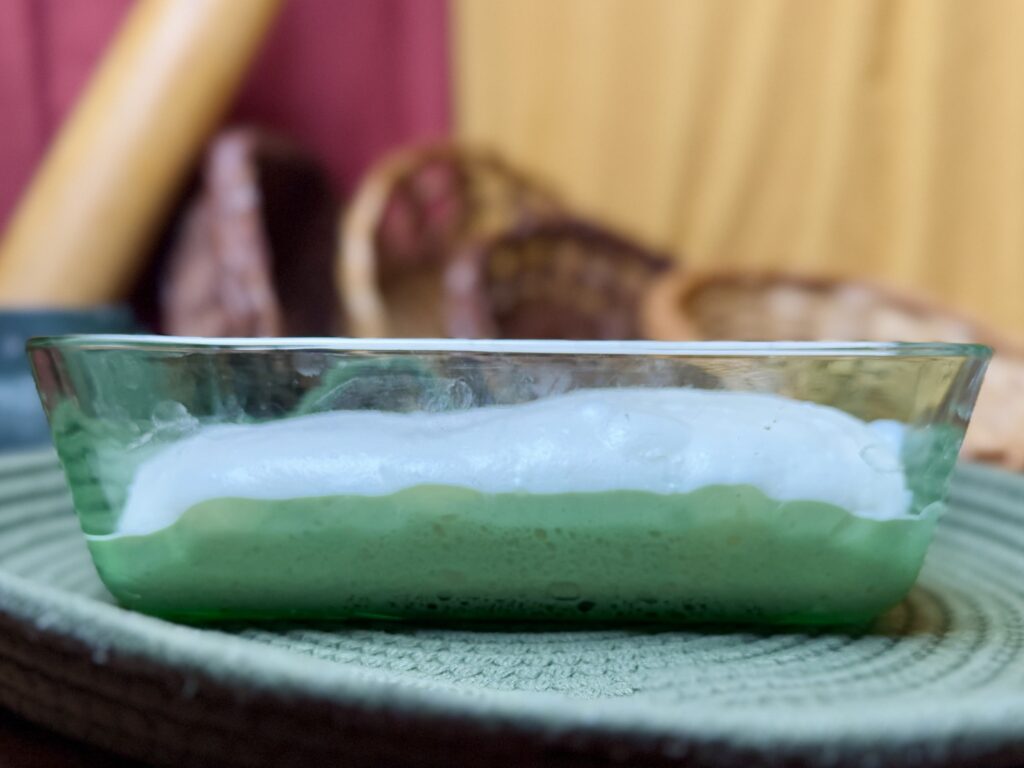
Temperature
This loaf needs a careful balance: cool enough that the butter doesn’t melt or turn greasy, but warm enough that fermentation still moves along. And with butter already slowing fermentation, finding that balance can get a little tricky.
From the time the starter is added, this dough takes about nine and a half hours to ferment at around 75 F (24 C). That’s a long time… and that’s not even counting the premix! If this were an overnight dough, I wouldn’t think twice about it. But with this method, we really need to manage temperature carefully. I recommend keeping the dough at an ambient room temperature of about 73–75 F (23–24 C). Try not to let it go over 75 F (24 C), but if it’s a little cooler (down to around 70 F/21 C), that’s fine—you’ll just need to let fermentation run a little longer.
Shaping
Some things about my shaping technique:
- When I only make one loaf of bread, I do not pre-shape (unless something went wrong during fermentation).
- Since I let the dough fill with air, which provides strength, I use a gentle shaping technique (demonstrated in a video on the recipe card).
If you are a pre-shaping advocate and want to chat about it, I’d love to have that conversation with you. But from my experience, it’s just not necessary for this recipe. I really only pre-shape if something went wrong during fermentation or if I’m dividing the dough and need each piece to be easier to shape later. Since this dough is already full of air—thanks to strong gluten and a full fermentation—it doesn’t need the extra tension or development that pre-shaping would add.
The same goes for final shaping. With this method, we don’t need to add a lot of tension because the dough already has a strong gluten network and plenty of gas built up during fermentation. That internal strength helps the loaf stand tall without needing to be forced into shape. A simple, gentle rolling technique (which I show in this video) creates just enough tension to help the loaf hold its form.
Cold Proof
With this method, I find that a cold proof is absolutely necessary. Not only is this a daytime timeline, but it’s also done at cooler temperatures with an extended fermentation (thanks to the butter). Without a cold proof, you’d end up baking late into the night (and waiting forever for the loaf to cool!) just to finally enjoy a slice! Plus, the cold proof resets the temperature of the butter, firming it up so you get those dreamy, melty butter pockets when you bake.
Beyond the butter, I usually cold proof my country-style breads too. It just fits better with my daytime baking routine: I can be around during bulk fermentation to fold the dough and watch for the right size increase, then shape it and pop it into the fridge at the end of the day. The cold proof not only builds flavor overnight, but also creates just enough condensation on the loaf so I don’t even have to add extra water or steam to my Dutch oven. It’s a win-win, and easily my favorite method for this kind of bread.
Scoring
When it comes to scoring, I like to keep it super simple. Usually, I just do one clean slash, about 1/4 to 1/2 inch deep, that’s it! But honestly, you can score this loaf however your heart desires.
The main goal of scoring is to release tension at a specific spot, so the loaf expands exactly where you want it to, instead of cracking or blowing out randomly. If the dough is well-fermented with the right balance of stretchiness (extensibility) and strength (elasticity), you don’t even have to score it!
Using a sharp razor will give you the cleanest score, which can help with both expansion and looks. But if all you have is a pair of scissors, go for it! And if you’re worried that scoring will drag and deflate your dough, it’s totally fine to skip it altogether and let the loaf open up naturally.
Baking Method
Normally, I like to bake my loaves around 500 F (260 C). But with my new, smaller oven, things bake much more efficiently, so I’ve started lowering the temperature to 450 F (230 C) to keep them from burning. With this loaf especially, it’s important not to bake too hot—the butter’s milk solids brown quickly at high temperatures, which can darken the crust more than we want.
I always love using the Dutch oven method for steaming bread. The enclosed environment traps the moisture evaporating from the dough and circulates it, helping the loaf expand beautifully. Then, once the loaf has finished expanding, I remove the lid so the crust can set and turn perfectly crisp and golden.
If you don’t have a Dutch oven, no worries! You can bake the loaf uncovered. Just toss some boiling water or a few ice cubes into a hot pan in the oven during the first part of the bake. This will create the steam you need to help the loaf rise before the crust sets.
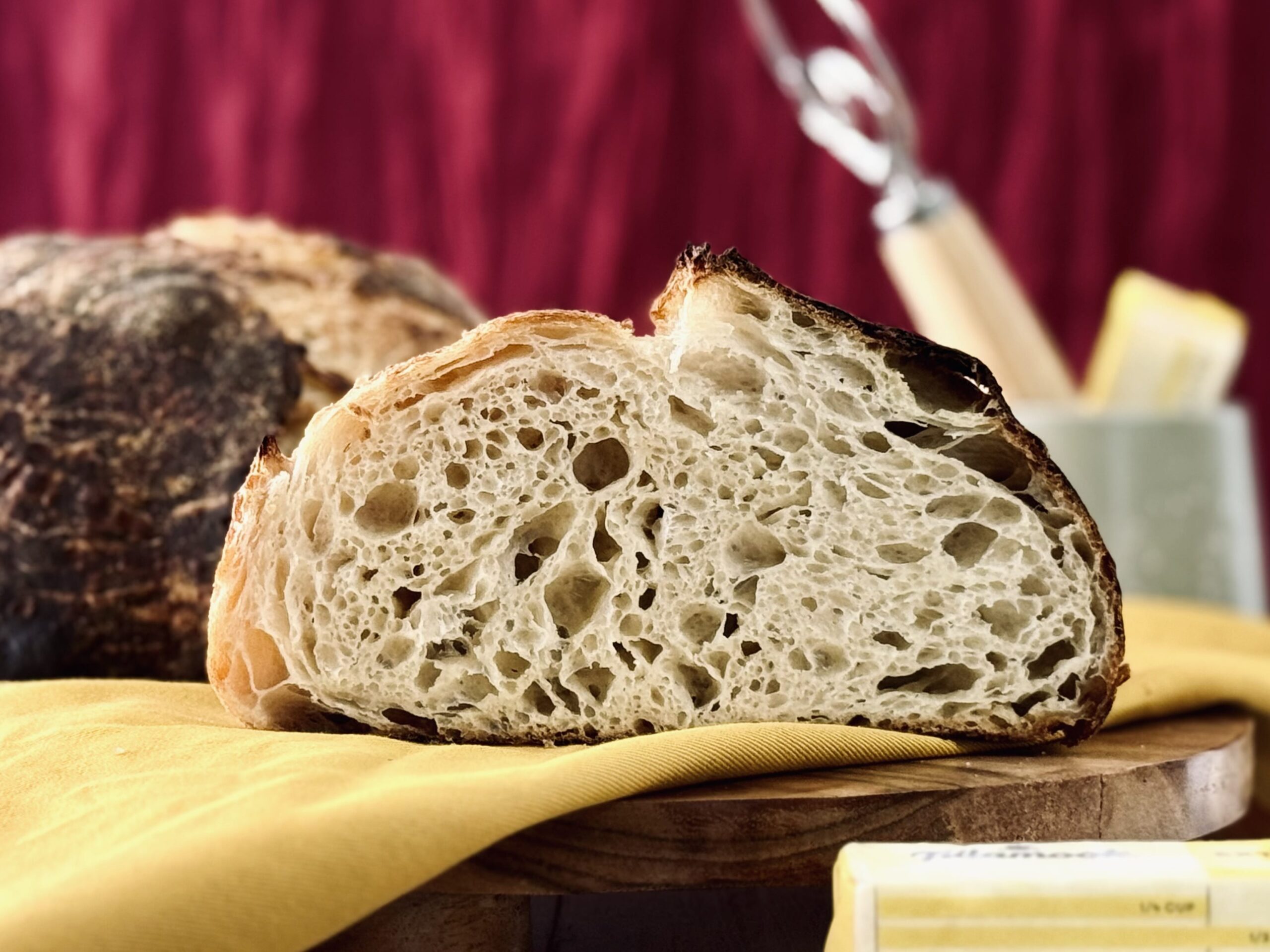
Suggested Timeline
DAY 1
8:00 a.m.
- Premix the flour, salt, and water.
11:00 a.m.
- Fold in the starter.
11:30 a.m.
- Laminate and add butter.
12:30 p.m.
- Coil fold the dough.
2:30 p.m.
- Coil fold the dough.
8:30 p.m.
- Shape and refrigerate.
DAY 2
8:00 a.m.
- Preheat the oven.
9:00 a.m.
- Bake and enjoy!
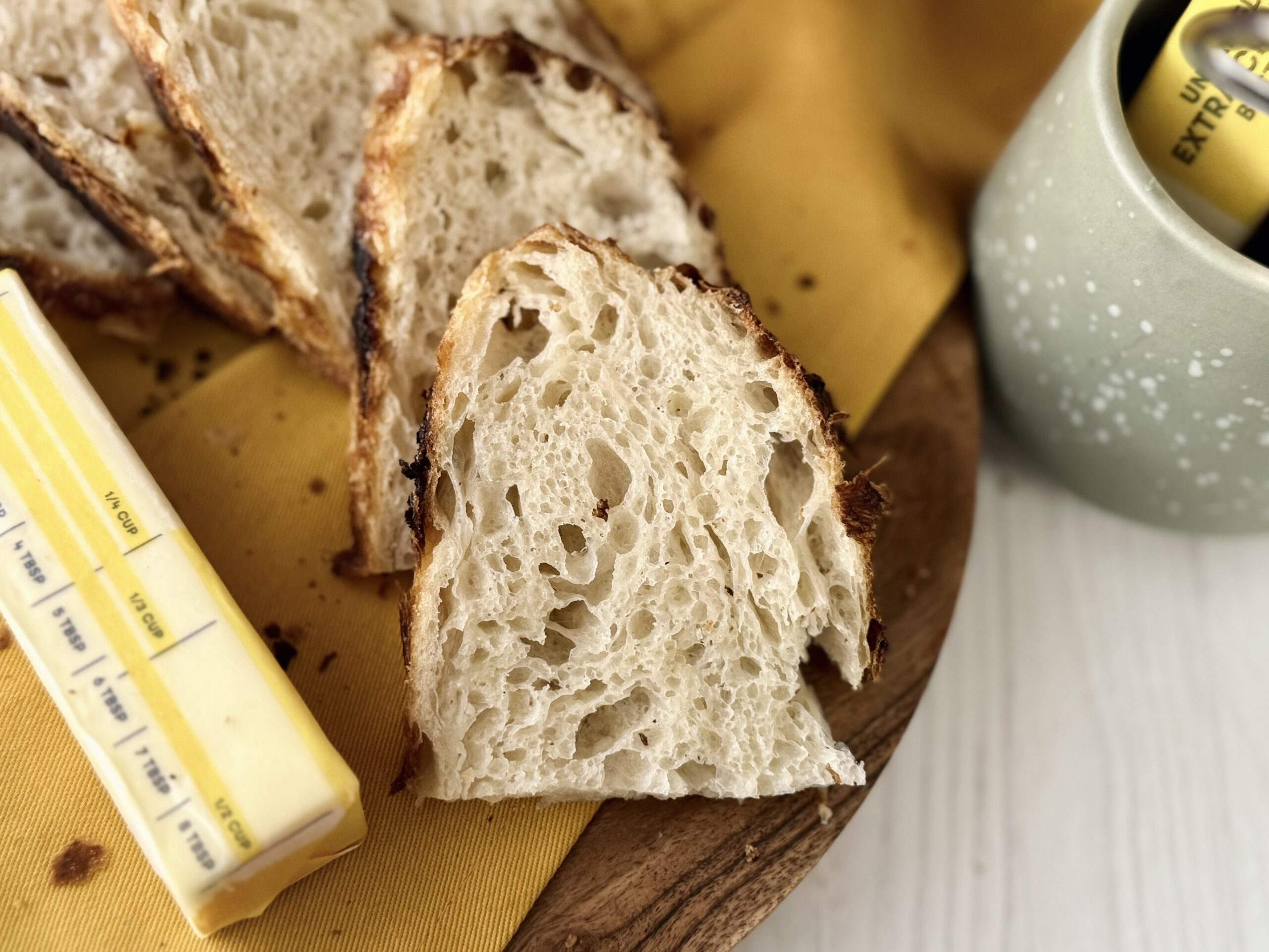
📌 Quick Tip: Read the recipe in its entirety before you start cooking. This will help you understand the ingredients, steps, and timing involved, and allow you to prepare any necessary equipment or ingredients beforehand.
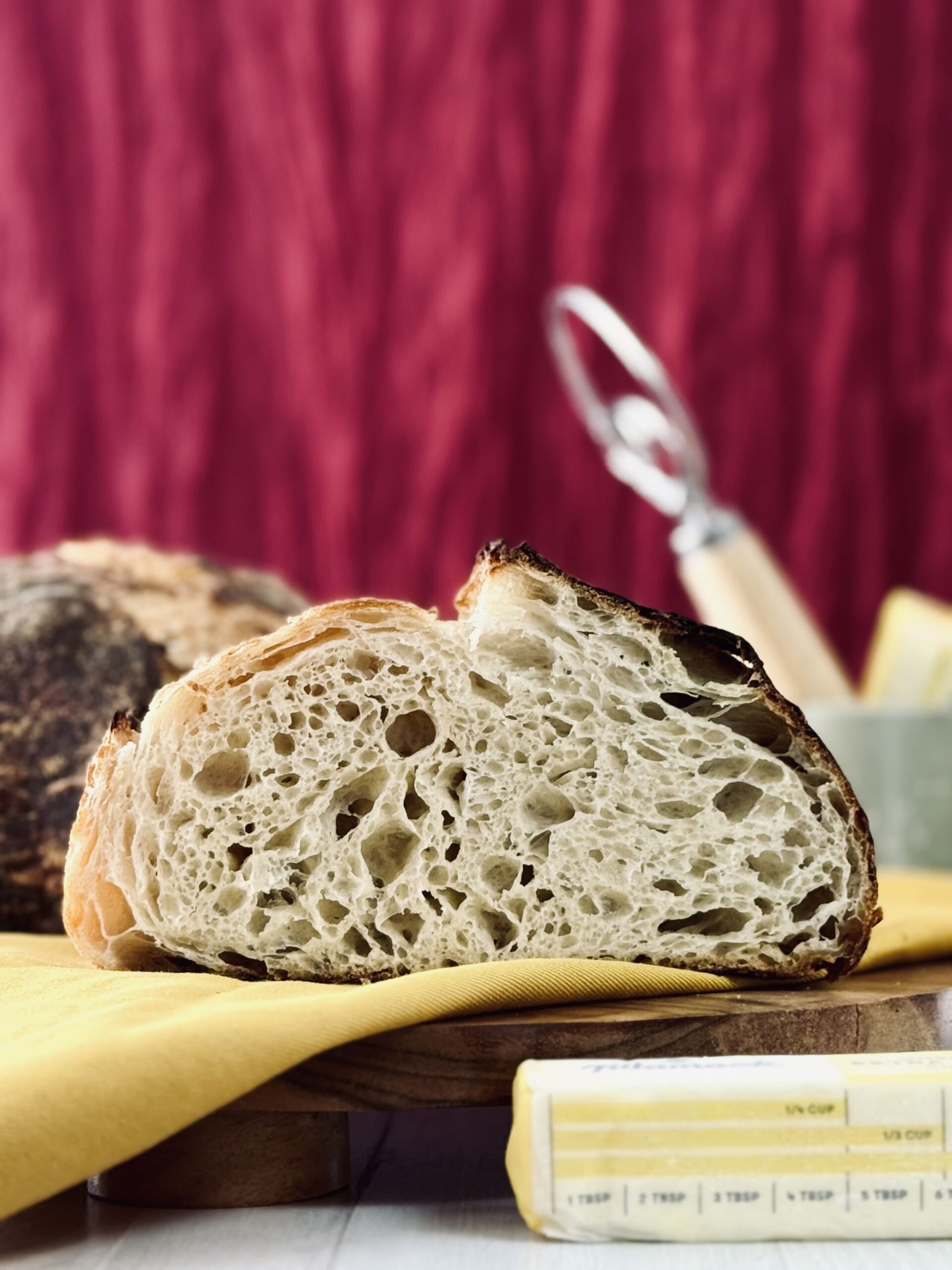
Croissant Country Bread
Ingredients
Instructions
-
Premix
In a 2-qt mixing bowl, combine all of the flour, salt, and water. Rest 2-4 hours (73-75 F; 22-23 C) before incorporating the starter. -
Add Starter
When both the starter and the dough are ready, smear the starter on top of the premixed dough, then perform as many coil folds as possible to incorporate the starter through layering without tearing the gluten network. Cover and rest for 30 minutes (ambient temp 73-75 F; 22-23 C).
-
Laminate
After 30 minutes, laminate the dough. This step further incorporates the starter, strengthens the dough, and adds the butter to the mix.
To laminate: Lightly spray your work surface with water. Turn the dough out onto the surface and gently stretch it into a rectangle, being careful not to tear it. Grate most of the butter evenly over the dough. Fold the dough into thirds, like a letter, adding any remaining butter as you go. Then roll the dough up, adding even more butter if there's any left.
Transfer the dough to a proofing container (I switch to an 11-cup Pyrex container at this stage), cover, and let it rest for another hour (ambient temp 73-75 F; 22-23 C).
It's important not to let the dough get above 75 F (23 C), as we do not want the butter to melt. -
Coil Fold #1
After one hour, give the dough one set of coil folds to add structure and further disperse the butter. Rest another two hours (ambient temp 73-75 F; 22-23 C).
-
Coil Fold #2
After two hours, give the dough one more set of coil folds. Cover and rest until the dough has doubled in volume, or filled an 11-cup Pyrex container 2/3 of the way to the top, about six more hours (ambient temp 73-75 F; 22-23 C).
At 73-75 F (22-23 C), bulk fermentation should take approximately 9.5 hours in total (from the time the starter is added to the time the dough is shaped).
-
Shape & Refrigerate
Turn the dough out onto a lightly floured counter. Shape the dough using a gentle shaping method.
To do this, fold the left and right sides of the dough into the middle, like a letter, then gently roll the dough up and pinch the edges closed.
Dust the top with rice flour, then gently place the dough upside-down into a 500 g banneton (I use this wood-pulp banneton from Bulka). Pinch the seam closed and pop any air bubbles. Cover and refrigerate overnight at 38-40 F (3-4 C).
-
Preheat Oven
The next morning, preheat an oven to 450 F (230 C), with a cast iron Dutch oven inside, for one hour before baking the bread.
-
Score
After the oven is preheated, turn the dough out onto a silicone sling or parchment paper and score 1/4 to 1/2 inch deep. Optionally, spray lightly with water. Transfer to the Dutch oven and cover.
-
Bake
Bake the bread with the lid on for 20 minutes, then remove the lid and bake for 15-20 minutes more, until browned to your liking. The internal temperature should register at least 200 F (93 C).
-
Cool, Slice, Enjoy!
Cool the loaf for no less than 30 minutes before slicing. Enjoy!
Nutrition Facts
Servings 12
- Amount Per Serving
- Calories 168.95kcal
- % Daily Value *
- Total Fat 6.03g10%
- Saturated Fat 3.46g18%
- Cholesterol 14.33mg5%
- Sodium 151.15mg7%
- Potassium 37.61mg2%
- Total Carbohydrate 24.17g9%
- Dietary Fiber 0.82g4%
- Sugars 0.36g
- Protein 4.18g9%
- Vitamin A 45.6 IU
- Calcium 9.77 mg
- Iron 1.51 mg
- Vitamin E 0.28 IU
- Vitamin K 0.59 mcg
- Thiamin 0.27 mg
- Riboflavin 0.17 mg
- Niacin 2.48 mg
- Vitamin B6 0.01 mg
- Folate 13.09 mcg
- Vitamin B12 0.01 mcg
- Phosphorus 36.01 mg
- Magnesium 9.52 mg
- Zinc 0.31 mg
* Nutrition values are auto-calculated and should be used as an approximation only.
Notes
- Storage: Store in a Ziploc or bread bag on the counter for three to five days, or slice and store in the freezer. Toast to warm.
- It is perfectly normal for butter to leak out the bottom during baking. However, if there is an excess amount of butter, there may be a problem with its incorporation during bulk fermentation.


